From Biddulph to Bermuda
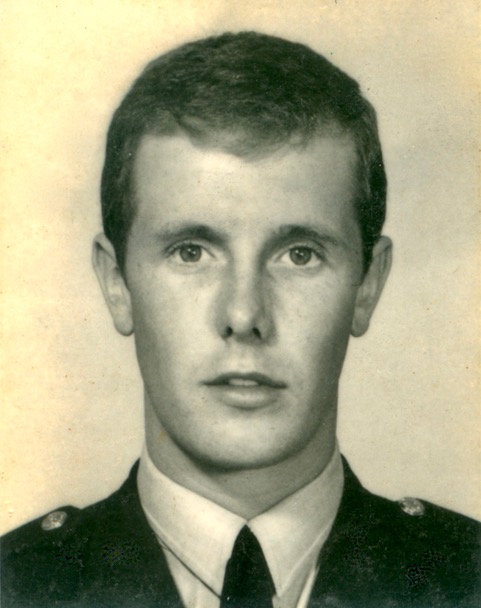
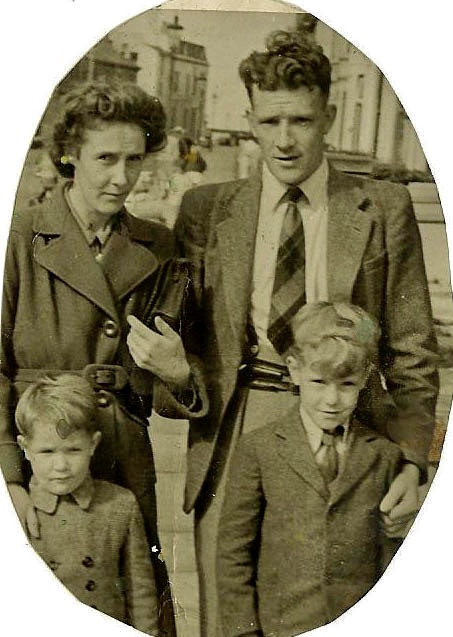
We weren’t exactly world travelers! Holidays usually consisted of a trip to Blackpool or Rhyl, or to Portmadoc in North Wales; although we took a family holiday in Aberdeen when I was eleven. We never owned a car while I lived at home, never had a refrigerator, and never had a telephone which I’ll mention again later.
While at school I played cricket and went on to captain our local junior cricket team, Knypersley, winning the prize for best batsman the year I was captain, and receiving it from our legendary former professional, Frank “Typhoon” Tyson. I was also involved with organizing a youth club in Biddulph . While at Wolstanton I had one venture into acting with a series of bit parts in a production of Hamlet, with a cousin playing the lead role.
For the vast majority of people in Biddulph and the surrounding area the choices for employment were either “Pit or Potteries! My dad made it clear to myself and my two brothers that following him down the pit as had his brothers, his father and grandfather, was not an option.
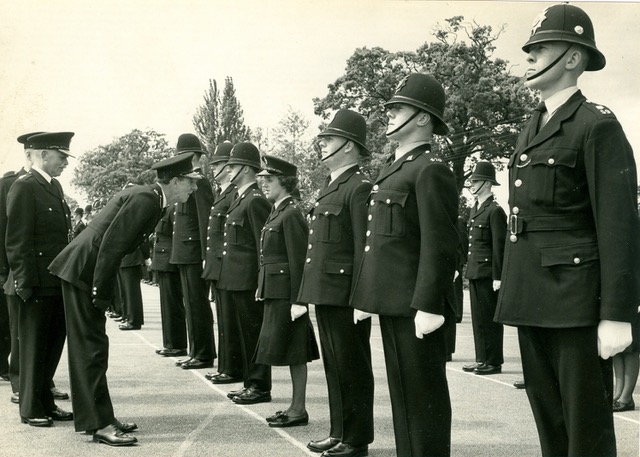
Bilston was an industrial town in decline in 1961 in the heart of the “Black Country”. I was the first new recruit in Bilston for several years but was given first class training by the men and women I worked with. One of my first Sergeants, Les Tarplee, gave the appearance of being rough and tough, and terrifying, but he was also a great mentor who had a heart of gold – and a habit of running his red pen through anything that was badly typed on a manual typewriter - in triplicate on carbon paper. It was great training because mistakes were not tolerated!
During the terrible cold winter of 1962-63, when we endured a 90 day spell of below freezing weather 24/7, I began to question whether walking the beat in Bilston wearing pyjamas under my uniform trying to stay warm was the career I really wanted. In early 1964 an uncle showed me an ad in a national newspaper for the Bermuda Police and I decided to apply.
After receiving a letter inviting me for interview I travelled down to London for the interview at the Crown Agents with Commissioner George Robins and Inspector Syke Smith. I was later told that I was one of over 600 applicants. I remember Syke asking me if I thought I could adapt to working in a community where the majority of the population was “coloured”. I could honestly answer that it wouldn’t be a problem because by that time Bilston was a multi-cultural community with thousands of immigrants from the West Indies, India, Pakistan, Fiji, and around the world. Mr. Robins was interested in whether you were involved sporting activites and I had been fortunate enough to play regularly for my Divisional and my County Police cricket team.
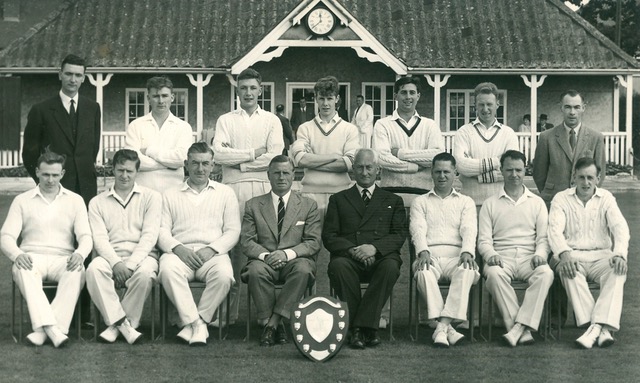 Bilston Division Cricket Team
Bilston Division Cricket TeamI’m sure many UK recruits experienced the same reaction getting off the plane (my first flight except for a brief twirl around Blackpool Tower with my mother as a youngster); I was shocked at how warm the engines were as we walked down the gangway, until realizing the breeze was blowing INTO my face and the warmth had nothing to do with overheated engines!
We were picked up at the airport by the immaculate and ever congenial Sgt Ken Morris, and transported to Prospect where we were shown to our 10’ x 10’ barrack rooms - mine being in Henderson Block where Sgt Arthur Rose was the senior man. Other occupants included Andy Bermingham who had arrived shortly before me, Ian “Baby” Douris who had a unique laundry system, and John Rawson formerly of the Nottingham Police who was a star rugby player on the Police Team.
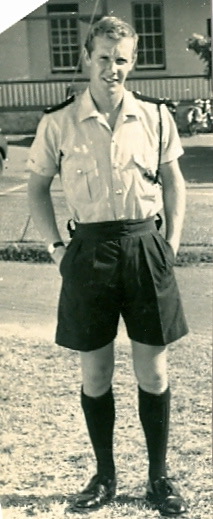
Ken Morris had advised us that females were not allowed in the barracks, but the next morning as I was shaving in the communal bathroom next to John Rawson I caught a fleeting glimpse of someone in a ladies nightdress slipping into the toilet. When I casually enquired if that was a woman I just saw, John assured me quite nonchalantly that women were prohibited from the barracks, but she sure didn’t appear to be a cross-dresser when she emerged again. It turned out to be John’s lovely girlfriend, and just one of a number of frequent female visitors to Henderson Block. Some rules are made to be broken!
On my first full day, which was cloudy and completely overcast – or so I thought - we were driven down to Admiralty Cove which was then being used exclusively by policemen and nurses. Admiralty House itself had served for a while as police barracks but became too dilapidated for this purpose. Several policemen, including Derek Jenkinson and Dave Garland were sailing snipes, and the dock was occupied by a bevy of lovely young nurses from King Edward Hospital. Overlooking the dock was a magnificent figurehead of Neptune with his trident from HMS Irresistible. We sat on the edge of the dock chatting with the nurses and swam for hours. It sure was a far cry from Bilston. But I was in agony that night after suffering the worst sunburn I’ll ever have, across my shoulders – and that was without ever seeing the sun!
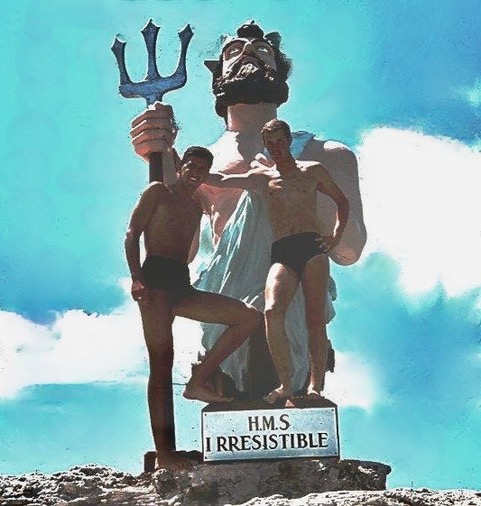 "Irresistible!"
"Irresistible!"
It took a while to settle into this new lifestyle. Within days of arriving I managed to pick out some matching furniture and curtains from other empty rooms; obtained free posters from the airlines in Hamilton, bought myself a tiny little fan – there was no air conditioning in the rooms, offices or Police Stations in 1964 - finally learned how to wash and iron my own clothes (Ian “Baby” Douris had a system whereby he threw all his dirty clothes into the bottom of his wardrobe until he had nothing left to wear, and then did his laundry), and went off to the Bank of Butterfield for a loan to purchase a scooter - a Triumph Tina.
Shortly after arriving I’d been on the beat in Hamilton when I received an urgent call to go to my room, get changed into casual clothes, and leave the door open! I did as told and a few minutes later Commissioner Robins entered Henderson block with Her Majesty’s Inspector of Colonial Police, and I heard Mr. Robins chatting about the “new” barracks and maybe they might find one of the young men around! They were accompanied by a photographer and this was the one and only occasion when I had photos taken in my barrack room.
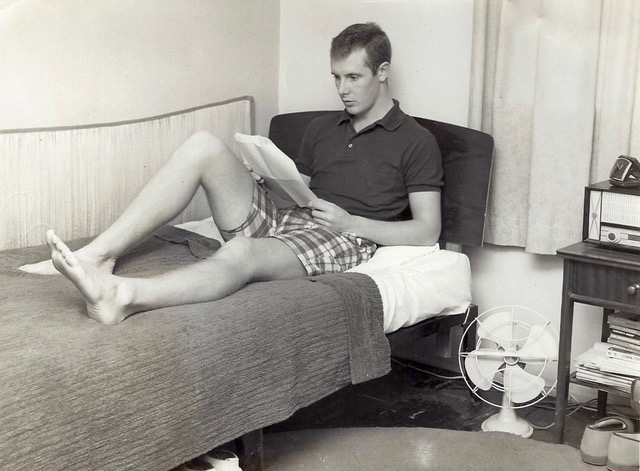 Roger relaxing in his room as ordered!
Roger relaxing in his room as ordered!
Our duties at that time consisted of either walking the beat, with Beat 1 being at the west of Hamilton, Beat 2 being close to the city centre, and Beats 3,4 and 5 being in east and north Hamilton. We were also required to do guard duty either on the Docks or at Government House. We usually had about 8 –10 constables on parade with one as Station Constable and another as the Duty Driver in a Morris Minor Station Wagon.
By far the worst duty was standing outside No. 5 Gate at the height of summer under the roasting sun, with no shade, checking anyone entering or leaving the docks in the days before the shipping industry used containers, so cargo was stored on pallets in the sheds and was always subject to theft. One sadistic sergeant insisted that when guarding No. 5 gate we had to stand outside in direct sun, which quickly resulted in us being soaked to the skin with sweat during the summer.
Perhaps the highlight of our duties in Hamilton was directing traffic in the birdcage at Heyl’s Corner. At that time the “Bobby in the Birdcage” was said to be the most photographed policeman in the world. One thing for sure about the birdcage was the endless number of young ladies from the U.S. who had no hesitation chatting to whoever was directing traffic – and not being shy about it!
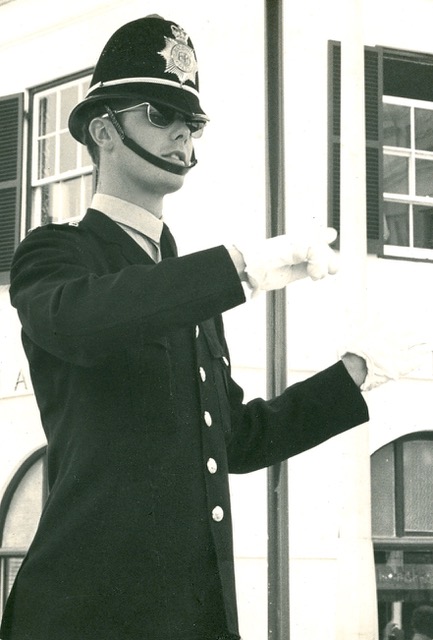 Roger on point duty at the Birdcage
Roger on point duty at the Birdcage
I was assigned to P.C. Gilmore Simons for the first few weeks and have remained good friends with Gilmore to this day. Most of my fellow watch members at that time were from the U.K. including Neil Cox, Dave Mulhall, and Dave Long. I loved walking the beat in and around Hamilton and getting to know the City, although I have to confess to getting lost one night in the area of St. John’s Road after straying too far. I chatted to an elderly gentleman walking along the road and diplomatically asked him if I was taking the quickest route to get back to Hamilton!

For evening meals most of us would eat at the New Queen Chinese restaurant on lower Reid Street above Chesley White’s furniture store. The head waiter, John, was tall enough to play basketball, and we could choose from anything on the menu, but if we went there later at night, they would sometimes offer us a free meal of whatever they had left over. Their food was always good.
The other popular spot for single policemen was The Spot on Burnaby Street, for breakfast and lunch when the Police canteen was not open. Loved their roast beef sandwiches with fries and gravy! It was then owned by Sheik Marirea, and Cleo was the waitress for many years. The Spot is still open and it is still a very popular restaurant for locals.
It was obvious that tensions were mounting in the days leading up to the riot because management at BELCO were not dealing with the workers demand for union recognition, and the union was completely frustrated with the police because it was our duty to see that they complied with the picketing laws which required, I think it was no more than 10 picketers at any one time, and although they could walk slowly across the entrance to BELCO they were supposed to completely clear the entrance before turning around in the opposite direction so that anyone wishing to enter the property would then be able to pass through.
I was there first thing in the morning on that fateful day and it was clear trouble was brewing, with the strikers getting more and more aggressive, but fortunately for me I was due to give evidence in Magistrate’s Court that morning and left before the rioting took place. And just for the record, all of the police officers on duty at BELCO that morning were in regular police uniform carrying nothing other than regular gear which included a small wooden truncheon and regular handcuffs.
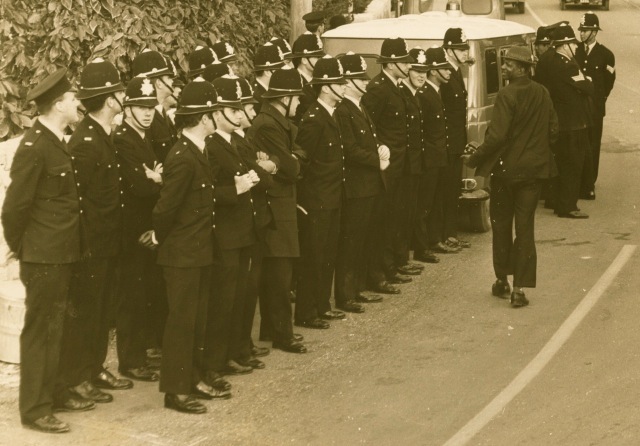 A group of some 24 unarmed policemen standing on Rosemont Avenue
A group of some 24 unarmed policemen standing on Rosemont AvenueShortly after I left for Magistrate's court, there was a scuffle when the officers on duty tried to assist an employee getting through the gate, and this resulted in P.C. Ian Davies being critically injured with serious head injuries. Some of the men at the scene had armed themselves with a variety of weapons and attacked the police officers who had only their small truncheons to defend themselves, until a riot squad was eventually dispatched to the scene and used tear gas to disperse the crowd.
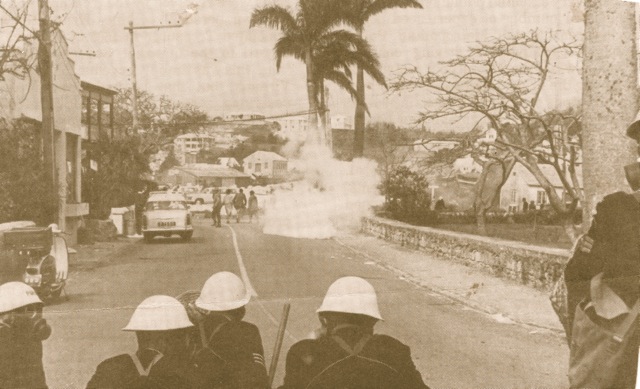
Gilmore Simons went on to be awarded the Colonial Police Medal for Meritorious Service during the riot, when he rushed to the aid of seriously injured Ian Davies. * Both Dave Mulhall and Dave Long were also there and both sustained injuries and had to be admitted to King Edward Hospital.
On the day after the riot we heard it had been reported in the British press that 70 Bermuda police officers had been injured in the riot. The total was in fact 17 who were injured. Commissioner Robins was very concerned that our families in the U.K would be unduly worried and he gave us all permission to make a long distance call to our parents - at Police expense.
This presented a logistical challenge to me because my parents still didn’t have a phone at home and neither did any member of our family. I hit on the ingenious idea of calling our local doctor, Doctor Miller; his son Roger had been my best friend since early childhood although by now he was an officer in the British Army. I made it a “person to person” call, and fortunately the doctor’s wife answered the phone and immediately picked up on what to do. She advised the operator that “Mrs. Sherratt” was not at home but would likely return in 15 minutes. She quickly drove up to our house (we still didn’t have a car) picked up my mum, and returned home to wait for my follow-up call.
I had been trying to devise a way not to alarm my mum and was stumbling over the words to explain that I was not one of the men injured in the riot. I was wasting my time! No-one in Biddulph had heard of our riot, and my mum was convinced the real reason for the call was to let her know I was going to marry an “Island girl”! Not a chance - yet. I was having much too good a time as a young single man in Bermuda, especially the nightlife at Forty Thieves Club, the Jungle Room, Bermudiana Hotel, Elbow Beach Hotel, the El Matador at the top of Queen Street, the Horse and Buggy, and occasionally very late night visits to the Musicians Club on Brunswick Street, and of course College Weeks.
CLICK HERE to read an extensive article about an event held at the BIU HQ on the 50th anniversary of the BELCO riot at which Andy Bermingham, Wentworth Christopher and myself were invited to speak as members of a panel discussing reflections on what happened on that morning in February 1964. CLICK HERE to see Gilmore Simons' account in our "Then and Now" column.
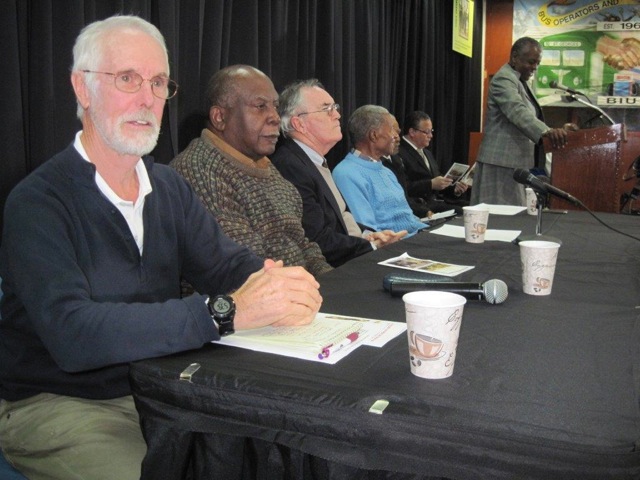
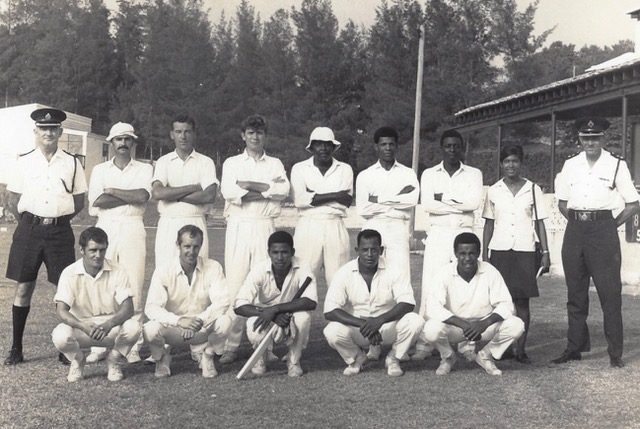 BCA Police Cricket Team circa 1969
BCA Police Cricket Team circa 1969
We also had an active tennis team - Arthur Rose, Bob Hay, Peter Stubbs, George Garrod, and John Van de Weg who became my regular partner for a couple of years, among others although prior to arriving in Bermuda I had never played tennis.
Two popular venues for parties were the Police Club cellar which was small and damp but within yards of our barracks, and a cave down at Admiralty House which was perfect during the summer months. We also had parties in the barracks from time to time, but had to be cautious because of the “no women” rule. Needless to say, the enforcement of our rules were a far cry from the nurses quarters.
One of our most disastrous parties was an all-male event held in Stourton Block just below Henderson Block. As though we needed any more reason to drink heavily, a few guys were betting they could down a full glass of rum in between the time it took for two 45rpm records to change on the turntable. Tommy Barnes tried it at least twice before succeeding, but he passed out and had to be carried over to his room in Henderson Block. We were all very concerned about him and left notes in our bathroom and on his open door for anyone going to work that morning to check on him.
Someone checked him around 7am, someone else around 8am and he seemed okay but when someone checked him just before 9am (I think it might have been Mike Jent who was the last person in the world to check on sleeping policemen), he found Tommy in a coma, apparently having choked in his own vomit. He was rushed by ambulance to KEMH and we were told it was touch and go whether or not he would pull through. Fortunately, he eventually came around apparently none the worse for the experience. They breed ’em tough in South Shields!
One brief story about Tommy, who became an excellent dog handler and also lived in Henderson Block. One night he and I were on patrol in a traffic car driving along Middle Road in Smith’s when we came across a cat that had just been run over. It was very badly injured, and screeching in agony. I had no idea what to do other than call a vet but that would have done nothing to put the poor creature out of its misery. Tommy had worked in a knackers yard before joining the Police in England, and he told me to approach the cat and try to keep its attention, while he approached it from behind, took out his truncheon and killed it instantly with one quick lethal blow. This might sound cruel, but he sure put the poor creature out of its misery.
 Police Squash Team Members
Police Squash Team MembersColin “Dusty” Hind, along with Ron Shelly who had left Bermuda before I arrived, was the force behind the drama group, and the cast for Seagulls included characters such as Jack Rouse, John Mulholland, John McQuaid, Tommy Doyle and Dave Long, and of course “Dusty Hind” who had previous professional acting experience. The Production Staff were excellent and included such characters as Bill “Spider” MacKenzie, Robin Henagulph, John Barnett, John Logan, Peter Stubbs and Derek Fletcher.
There was great cameraderie amongst the cast and crew, and being a member of the drama group was a wonderful experience for someone who had arrived in Bermuda quite reserved and shy!
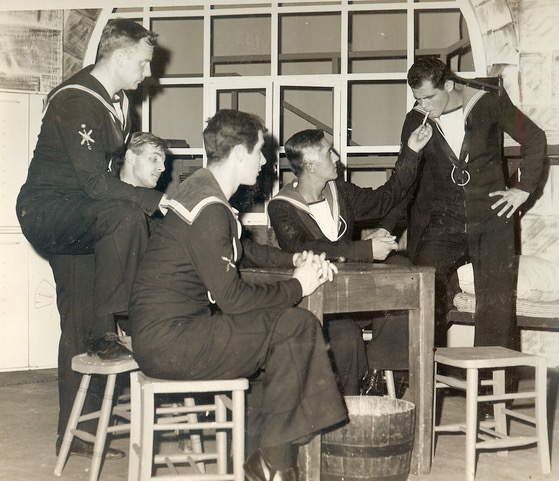
Performing in Seagulls also gave me an insight into what it is to be “professional” on stage. There was a point in the play when a letter from one of the characters was found and opened by his fellow sailors after he had been tragically killed in an explosion. Dusty Hind had the task of reading the letter, with several of us gathered around him in sombre mood. I happened to glance over at what Dusty was reading and almost fell over when I realized that someone had replaced the correct wording in the letter with just two words, “F--- You”! Dusty never skipped a beat but I doubled up in uncontrollable laughter. I was astonished to read a subsequent review by David White in the Royal Gazette describing this scene and praising Able Seaman Simms for his most moving reaction to the letter when he broke down in tears!
I appeared in two other Police productions, the well known comedy, Arsenic and Old Lace in 1966, with some excellent female actors, and Journey’s End in 1967 which was an ideal play for our Drama Group as we were fortunate to have a large group of male actors as well as in-depth back stage crew including lighting, sound, set design, stage manager and stage hands, and Nick Hall supplying all of the uniforms from who knows where!
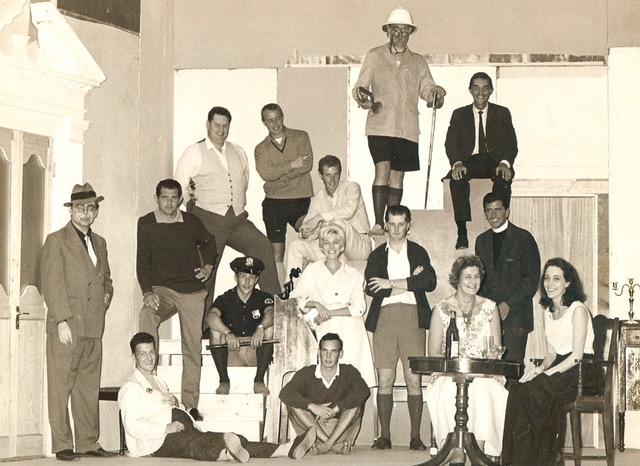 Cast and crew from Arsenic and Old Lace
Cast and crew from Arsenic and Old Lace
Bermuda theatre is a far cry from Hollywood, but each year the Bermuda Sun would announce their annual “Sunburst Awards” for achievements in local theatre. In terms of awards “Journey’s End” was our most successful production which tended to support the public's point of view.
The 1967 New Year “Sunburst Awards” season resulted in Journey’s End winning the following:-
Play of the Year – Journey’s End (Police Drama Group)
Director of the Year - Tony Block (Police Drama Group)
Best Supporting Actor - John Mulholland (Police Drama Group)
Most Promising Young Actor of the Year – Roger Sherratt (Police Drama Group)
Best Set-Designer - Dennis Byrne (Police Drama Group)
CLICK HERE for more about the history of the Police Drama Group on our ExPo website.

Our Police rugby team also excelled in competition, with matches being played at National Sports Club which was a very popular venue, especially for the expatriate community, complete with the best fish and chips on the Island.
Although I played rugby at school I had never played since then until Traffic entered a team in an Inter-Divisional Rugby Tournament which I seem to recall allowed no more than 4 regular players in the team. Our team included Gordon Howard, Ian "Baby" Douris and myself as the non-regulars, and we went on to win the final. That was my first and last game of rugby in Bermuda.
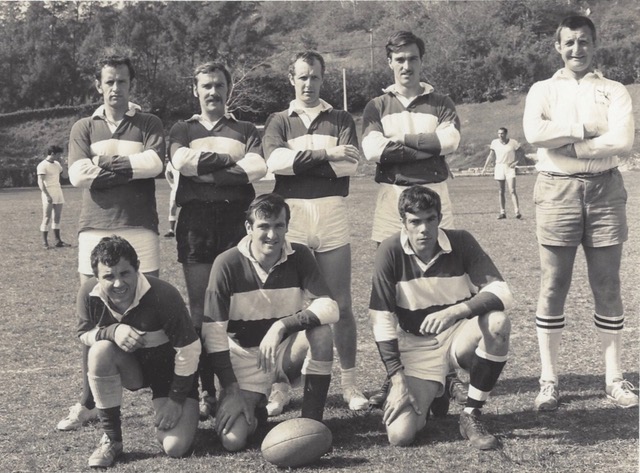 Operations Division Sevens Rugby Team
Operations Division Sevens Rugby Team
Commissioner George Robins had a policy of recruiting as many active sportsmen as possible on the premise that newcomers to the Island would settle in much more quickly if they participated in a sport or other social activity.
It was champagne and cigars only, and as a spectacle the whole evening was second to none, with a boxing ring set up in the main hall, red corner and blue corner, very professional referees, seconds, timekeeper, and MC Dave Parsons, all dressed for the occasion, superb lighting and sound system, programmes, a ticket only affair, and all that was needed was boxers with skill and determination and they were there in spades! The first fight, between Dave Cann and George Rose, started quietly with a few calls of encouragement during the first round, but by round three, “Shakey” Johnson stirred up the crowd and everyone in the hall was shouting and screaming for blood!
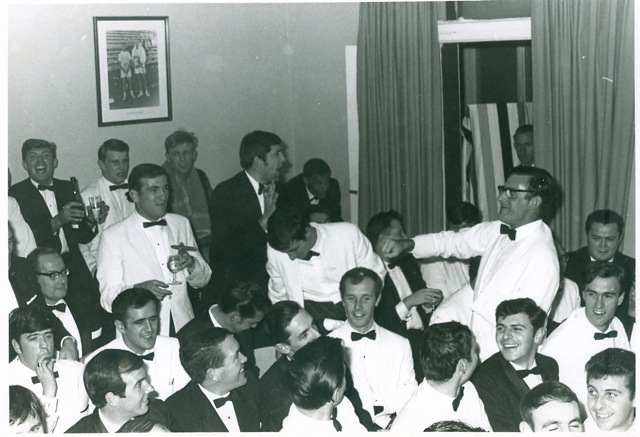
It was the same throughout the evening, the boxers, all of whom had trained hard for the big event, put on a tremendous show including several knockdowns. ‘Fight of the Night’ went to John Balsden and Davie Kerr, and Davie made his presence felt for many years to come. Some believe it knocked some sense into him - others think the reverse, but whenever Davie stepped into the ring you knew it was going to be one hellova fight! As Pat McBride predicted, the annual Evening of Boxing became an annual event for at least 25 years, eventually moving to the Southampton Princess Hotel with greatly increased seating capacity, but never empty seats as members of the public clamored to be invited. Those boxing evenings will always be fondly remembers by those fortunate enough to have been there.
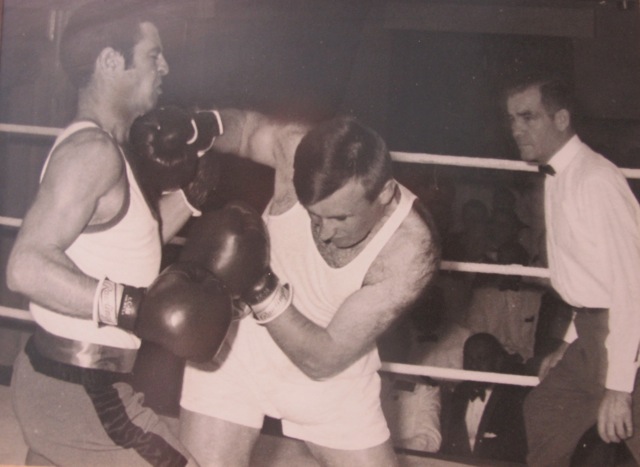
CLICK HERE for an article written in part by Pat McBride about that First Boxing Tournament.
But all their hard work and training paid off when they won the final at the Ag Show against an enormous N.O.B. Fire Brigade team who had been “heavy” favourites to win bearing in mind that two members of the Police team, Gary Perinchief and Ray Sousa, were lightweights! The team were not the only winners. Some bright guys in the audience, including Ian "Baby" Douris, made out like bandits betting heavily on the Boys in Blue!
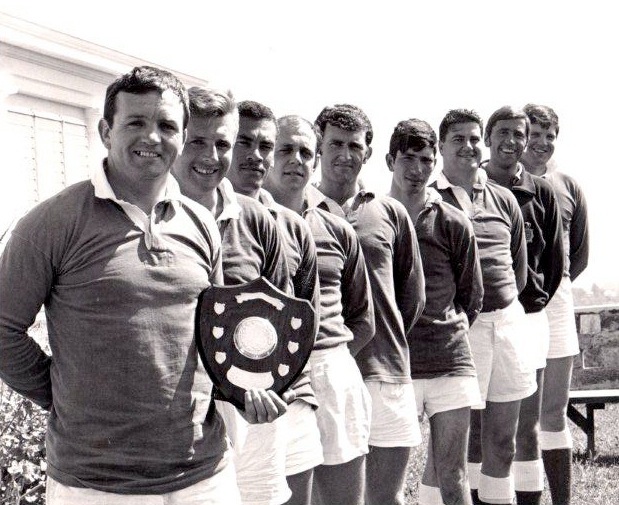
Pat and his team went on to win every competition they entered including pulls against visiting Royal Navy ships. It’s not often a team in any sport remains permanently undefeated. CLICK HERE for Pat’s account of the history of the Police tug o’ war team.
CLICK HERE for Pat’s account of the First PRC mini-Marathon which later became a popular annual event.
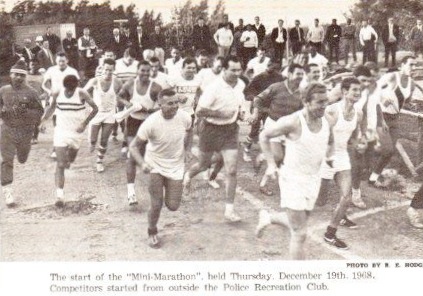 First PRC Mini-Marathon gets underway outside PRC - 1968
First PRC Mini-Marathon gets underway outside PRC - 1968
Other keen players included Mike Cherry, Ian Scotland who always insisted on wearing a weight belt and a rubber body suit, Arthur Rose and Ray Banks who were members of Bermuda’s Rosebowl Team, competing annually against the Bahamas, Jamaica and later the Cayman Islands, for the “Rosebowl”. Eric Sanderson and Barrie Mancell also went on to play in the Rosebowl, while players such as Gerry James, Fred Bean, George Garrod, Alf Hagar, Neville Darrell, Johnnie McConnie, John Swift and Harvey Fothergill and a host of other policemen enjoyed the game, perhaps due in large part to the fact that it gave you one heckova work-out in 40 minutes and could be played at any time of the day or night - ideal for policemen on shifts.
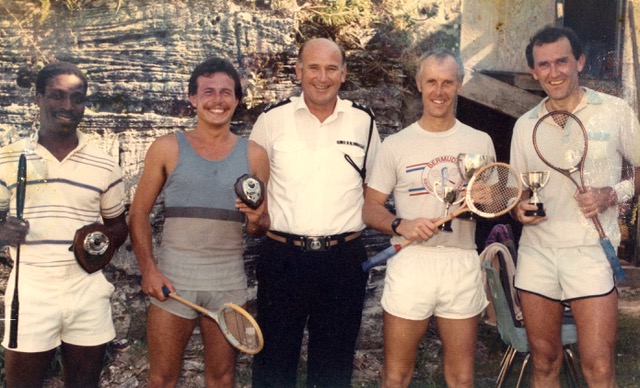
I believe I can claim a feat that might never be repeated again, and that is to have played for the Bermuda National Squash Team in Rosebowl competition for no less than five decades. My first trip was to Nassau in 1969, and I played through the 70’s, 80’s and 90’s, with my final trip being in 2001 to Cayman. I was also fortunate enough to win the Caribbean Veteran’s title in 1989 in Barbados - the same year my son, Tommy, also won the Caribbean Under 16 title.
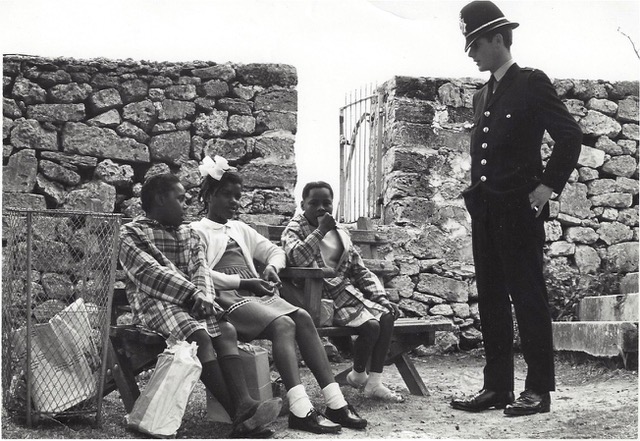 P.C. Roger Sherratt chatting with
P.C. Roger Sherratt chatting with
I made an arrest one night in Bernard Park of a young man named James Llewellyn Allen for being drunk and disorderly and resisting arrest. Nothing out of the ordinary except for the fact that he was carrying several suspicious items which turned out to be heroin and the equipment to use it. I never realized the full significance of this arrest until I was told many years later by Harold Moniz that this was the first arrest in Bermuda of anyone in possession of heroin.
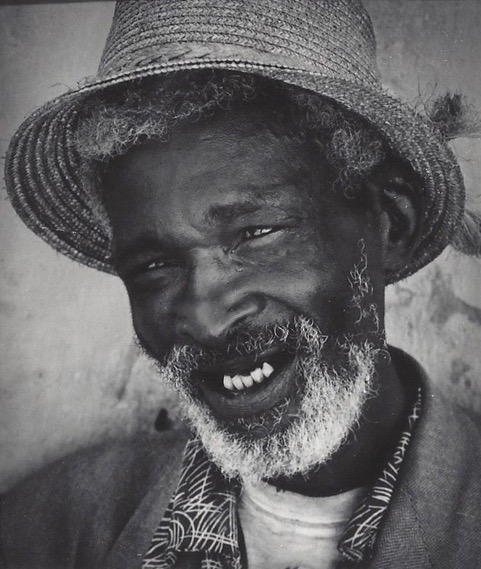
We were still having to deal with one of Bermuda’s great characters, that well known rummy, “Weatherbird” Mills, who to the best of my knowledge, never hurt anyone and was never violent except perhaps a day or two before Christmas at which time he would invariably smash a shop window near Hamilton Police Station if he hadn’t already been locked up in time to spend the holiday season at Casemates.
I helped to arrange a meeting at the Police Club and invited anyone interested in our ideas to attend. There was considerable interest and shortly afterwards I was invited to sit as the Police representative on a council created to organize a YMCA Youth Club on Island where I ran a table tennis league for several seasons.
One negative experience from that meeting at the Police Club. I had received a call from a very attractive young lady I had never previously met, who was interested in attending the meeting but she had no transport, so I made arrangements to pick her up on my scooter and take her up to the PRC. We arrived early, and as usual, meetings invariably started late, so I took the young lady, who happened to be black, into the bar for a drink.
The next day I was interviewed by a member of the Force wanting to know the identity of the young lady and why I was entertaining her in the Police Club. I was not very forthcoming in answering his questions, in fact I refused to do so, and a short time later I was transferred to St. George’s. This really didn’t make sense to me because the Police Force was then at the forefront of fully integrating our sports teams and setting a positive example to the rest of the community.
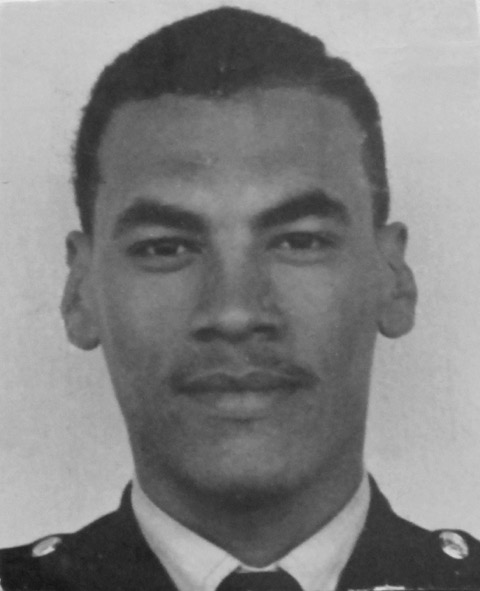 Gary Perinchief
Gary Perinchief
Unbeknown to most of us, as we were arriving at the hotel, the man in charge of the pool, who happened to be black, had approached Gary Perinchief and told him he was not allowed to swim in the pool because he was “coloured”. Most of us had no idea of this situation until we were well into the swim meet, but once we found out what happened we should, without doubt, have stopped the meet and walked out in disgust. The guys who organized the event went on to make a formal complaint about Gary’s treatment, and this was supported by then Commissioner George Robins. I understand that the Hotel was formally dealt with and this immediately resulted in a change in their policy to allow “coloured” people full access to the pool.
Fortunately for me, the chief driving instructor was Sgt Derek Jenkinson, who in my view was one of the finest and most efficient police officers I’ve ever had the privilege of working with. Derek called me up a few days before the course was due to begin and told me to report that morning to Driving School. He proceeded to teach me to drive in one morning, and arranged my driving test at TCD that afternoon. His first comment on seeing me drive was that the car must have been filled up with “kangaroo gas”! But I went on to pass the test that afternoon, and even went on to finish top of the course.
Believe it or not, of the six guys on my Basic Driving Course, only two managed to pass - four failed - and that’s when I realized that the Force sometimes really does move in mysterious ways! I had visions of being transferred to Operations (Traffic) which was then considered to be a move up the ladder, but when Daily Orders were posted on Friday afternoon, all four of the guys who had FAILED their Basic Driving Course, were transferred to Traffic, while the only two to pass, were sent back to the beat in Hamilton. Perhaps General Orders were written before the course results were known!
This meant moving down to singlemen’s quarters in St. George’s and as far away as possible from the Hamilton night life. It was also a time when the Forty Thieves Club was still in its prime and I spent many hours there seeing some of the world most famous performers, from Dione Warwick, Roy Castle, Tom Jones, and one of my favourites as a teenager – “Mr. Skiffle”, Lonnie Donegan. I wrote an article about the Forty Thieves for our ExPo website which can hopefully still be viewed by the public if you CLICK HERE
While in St. George’s I was invited to represent the Police on the organizing committee for a new Y.M.C.A. being set up on Island. I had a most upsetting incident with the OIC of St. George’s, Inspector Jim McMaster after I asked for permission to take time off on a Saturday morning to attend an official YMCA committee meeting in Hamilton. Although I applied several days early and we had a full complement on our Watch, permission was denied which seemed odd because I was attending as the Police representative. A day before the meeting I called in sick with a very sore throat and was unable to speak.
I stayed in bed for a couple of days then went to see Dr. Whalley, the Police doctor at the Department of Health on Victoria Street. He informed me that he was embarrassed to inform me that I was being accused of malingering by the Inspector in St. George’s. But as soon as he took one look at my throat he gave me a sick note for a week! On returning to work I approached Inspector McMaster and let him know that I didn’t appreciate having a doctor tell me that I was accused of malingering even before he had a chance to examine me. Inspector McMaster and I were not on the best of terms after that incident.
Not long after being transferred to St. George’s we were finally given permission to move out of barracks and I moved into the “Dog House” at Lukin Cottage off Watlington Road East, in Devonshire, with the Foster family of mother, Gwen, and her two lovely daughters, Angela and Nicky. They had endured an horrendous experience when “Eggs” Smith had broken into their house, and as a result they invited Dave Garland to move into their tiny apartment known as the “Dog House”. When Dave decided to move elsewhere he approached me and asked if I would be interested in moving out of barracks into the “Dog House”! I jumped at the chance.
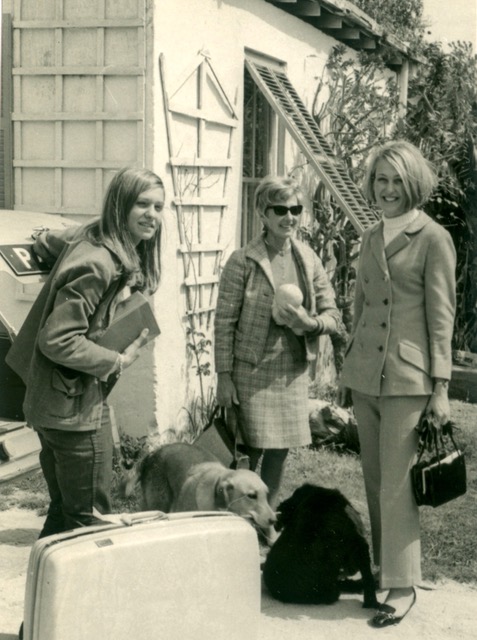 The Fosters in front of the “Dog House”
The Fosters in front of the “Dog House”Shortly after moving in I was joined by George Rushe and Barrie Mancell who stayed in the main house for a few months. I spent the next three years of my life at Lukin Cottage, and thoroughly enjoyed my time there. Gwen Foster was a truly amazing character who had worked as a “Land Girl” during the Second World War, and despite being at most 5 feet in height she was a human dynamo who played tennis, squash, and golf at Ocean View which was within walking distance. She also had two beautiful daughters, Angela and Nicki, and they became my family in Bermuda, a mum and two sisters. They whipped me into shape with house and garden chores!
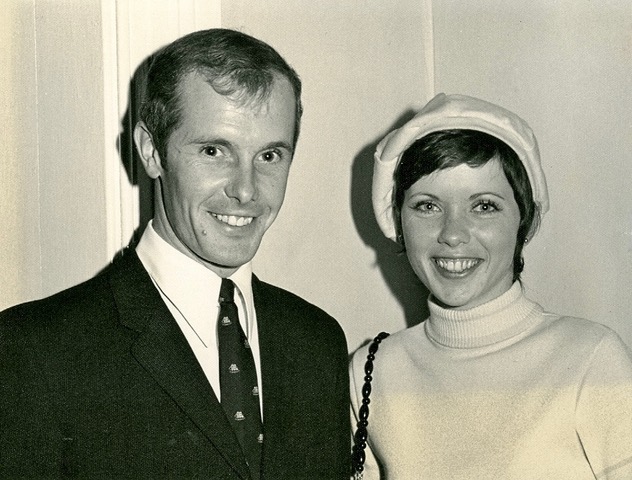
It was time for action! Ten days later I proposed to Marian and much to my relief and joy, she accepted, She cancelled her trip to Australia, and we were married 4 months later at Christchurch in Devonshire. Her father had died a year before we met, and on the big day she was given away by her “uncle” retired Inspector Jack “Tug” Wilson, and my Best Man was my good friend Alistair “Shakey” Johnson.
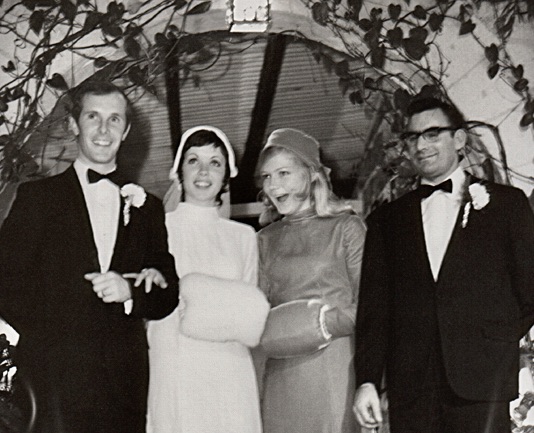 Bride and groom with Maid-of-Honour Sheila Blackburn
Bride and groom with Maid-of-Honour Sheila Blackburn I’m sure if my own daughter or granddaughter told me she wanted to marry a man she had known for only 10 days I would tell her she was crazy, but Marian and I have been happily married for over 50 years – so what could I possibly say!
George and I came up with the idea of listing all the roads in alphabetical order using a physical description for each one. For example, Hesitation Lane was described on our list as, “Drive east out of Hamilton along Middle Road in Devonshire, turn left on Montpelier Road, second road on left is Hesitation Lane.” It took us about a year to complete a list of the 1,200 roads, both public and private, and we then applied for permission from the Commissioner to publish them in a little booklet called the “Bermuda Gazeteer” for sale to the general public. Permission was obtained and the booklets were ideal for not only police officers, but also for taxi drivers, delivery drivers, and anyone who needed to know how to navigate the roads of Bermuda. They sold like hot cakes!
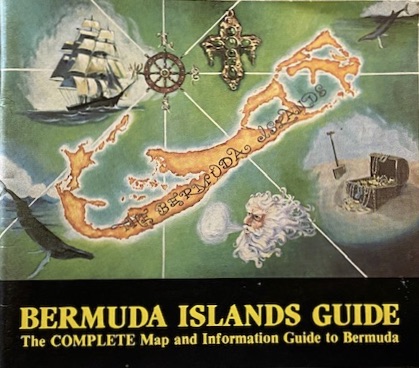 Front cover of Bermuda Islands Guide
Front cover of Bermuda Islands GuideWe later decided to produce a more sophisticated booklet, The Bermuda Islands Guide, “The COMPLETE Map and Information Guide to Bermuda”, which had 24 full-colour hand-painted pages of maps which also listed places of interest, hotels and guest houses, restaurants night clubs and bars, parks and nature reserves, small island and bays, even the locations of public telephones, plus all of Bermuda’s 96 churches. It was published in 1982 and for several years we organized ZBM’s treasure hunts based on clues compiled from names in the BIG. Unfortunately, it was never the financial success that we’d hoped for but we sure got to know the Island. Typical of George, he insisted that we include one or two deliberate mistakes in our maps in case anyone copied it – and sure enough they did – mistakes included!
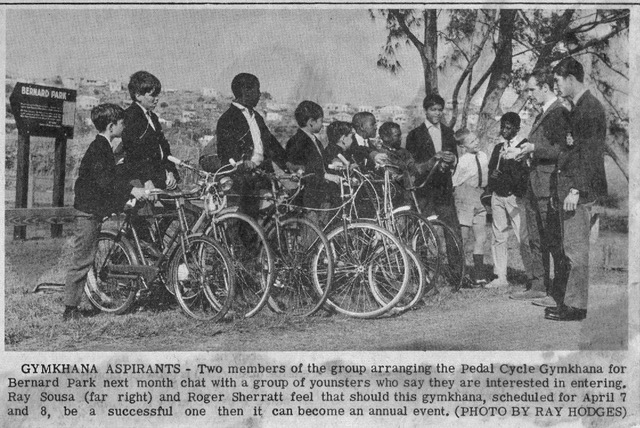 Bermuda Sun article about first Pedal Cycle Gymkhana
Bermuda Sun article about first Pedal Cycle Gymkhana
After obtaining permission from Commissioner Robins, we decided on a name for the event – the Police Pedal Cycle "Gymkhana" - a venue in Bernard Park; we visiting every school on the Island, approached sponsors from all sectors of the community including Mr. Ottiwell Simons, President of the BIU, and just to make it a truly special occasion we arranged for the fairly newly created Police Motor Cycle Display team to put on a display of their motor cycle riding skills which was a huge hit with people of all ages.
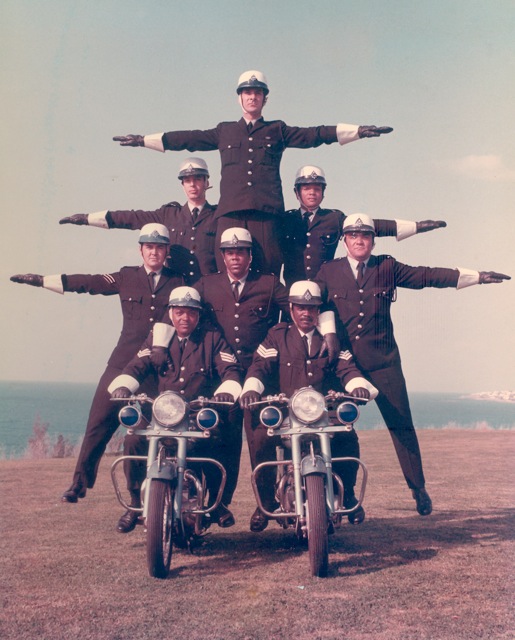
The event was put on for two days, with some 500 or more children on pedal cycles participating in races as varied as short sprints, lap races, slalem races, apple bobbing, and even slow races where the winner was the person who fell over last! Owen Marsh from the Police garage came down and inspected every pedal cycle to check on brakes and bells and make adjustments where possible, we had dozens of police officers who volunteered their help, every child was presented with a Certificate of Participation. It was a huge success and after that first year it has become an annual event held on the Police Field at Prospect to this day. CLICK HERE for Ray Sousa's article on The First Police Pedal Cycle Gymkhana 1969.
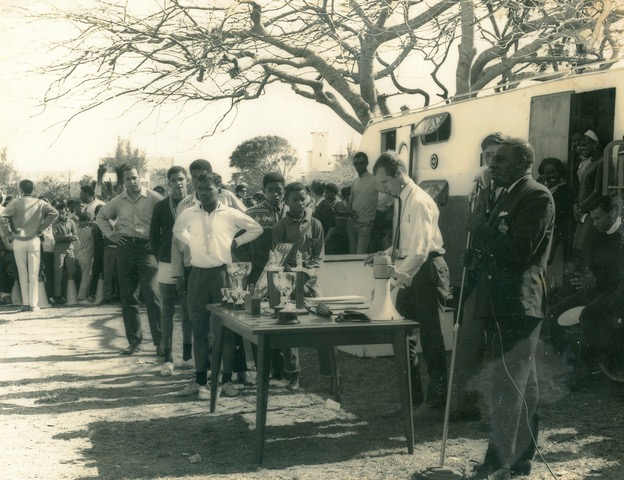 Prizegiving at our first ever Police Pedal Cycle Gymkhana
Prizegiving at our first ever Police Pedal Cycle Gymkhana
I was warned that Lady Martonmere was a stickler about sticking to the speed limit and that I should NEVER drive at more than 20 miles an hour - 15 miles an hour in Hamilton and St. George's. While on the advanced driving course, Derek Jenkinson showed us how to stop a car without any trace of jarring motion when coming to a halt. He told us that if you’re on a flat road and you’re coming to a stop, if you wait until you are almost stationery, then ease your foot off the brake, the car will glide gently to a halt.
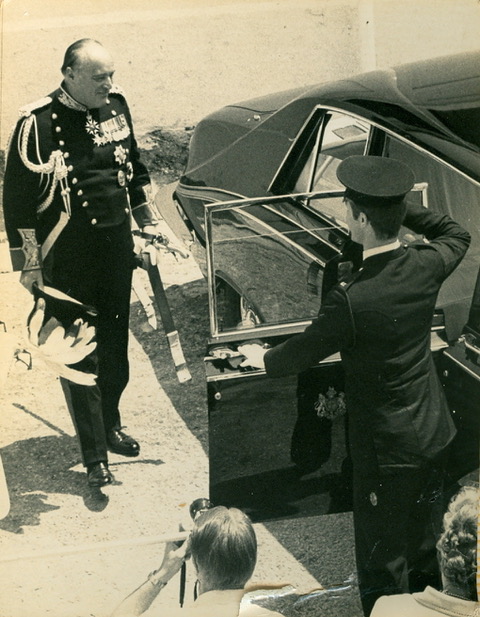 Roger with H.E. The Governor, Lord Martonmere
Roger with H.E. The Governor, Lord Martonmere
H.E’s car was a magnificent new Daimler, and I took Derek’s “smooth stopping” advice to heart, always driving exceptionally slowly when Lady M was on board, and making every effort to stop the vehicle without the slightest jolt!
A few weeks after our wedding I received another call to attend the Commissioner’s office where Mr. Robins informed me that H.E. and his wife were so impressed with my driving I was to be transferred to Government House on a permanent basis. It was the last thing I wanted to do so I politely explained that I much preferred being a policeman and wanted nothing more than to return to the Traffic Department. I wasn’t sure what his reaction would be but Mr. Robins gave me a broad smile and said, “Glad to hear it. We’ll get you back to real police work.”
I was very happy to return to Traffic and it was around this time that I started working on radar crew with Sgt Eddie “Boxhead” Foggo and Dai Thomas. We booked literally thousands of speeders with the new “point and shoot” radar devices. In fact we had to limit our “catch” to no more than 120 per week because there were two one-hour radar courts every week in Hamilton Magistrate’s Court just for our “clients”. The magistrates set a limit of 60 pleas in each one-hour session, with those pleading not guilty then set down for hearing at other times. We never had less than 120 cases in a week.
“Boxhead” was great to work with and had the biggest booming voice I ever heard. One night our two-way radio went on the blink, and that presented a problem because “Boxhead” would usually be on the radar machine in ther bushes or behind a wall, with Dai and I in the chase car some distance away. Not a big problem. We could still be 50 yards away from where Eddie was in the bushes and he would shout out the number and the speed so we could give chase.
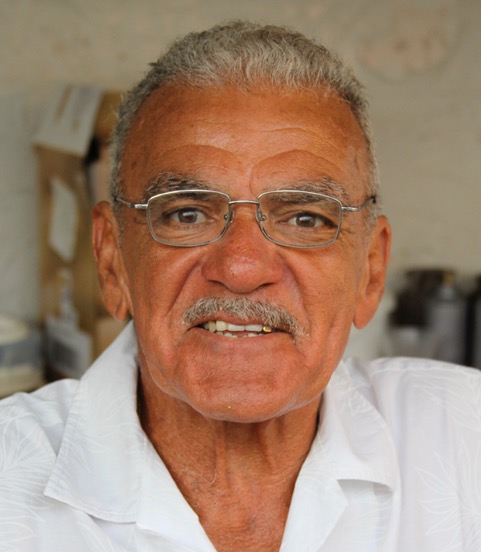 Eddie "Boxhead" Foggo
Eddie "Boxhead" Foggo“Boxhead” was, of course, a St. David’s islander and one evening he suggested that we head down to St. David’s Road, near where the St. George’s Police Station is now located. We had probably never operated mobile radar in St. David’s prior to that evening, and we had one of the busiest sessions ever! We started by booking anyone travelling in excess of 35mph, then 40mph but we were so inundated with high speeders we finally settled on stopping only those doing more than 50mph. It was akin to catching fish in a barrel. “Boxhead” decided we should go back to the same location a couple of evenings later, and it was just as hectic, with most of those stopped telling us they never thought we’d be back so soon!
We did have a major problem when we were ordered by “Nobby” Clark to do something about police officers speeding on Middle Road in Devonshire as they rode their civilian bikes between Hamilton Police Station and Prospect barracks. This had resulted in numerous complaints from the public and from Sir Henry Tucker who brought it to “Nobby’s” attention. It was the very last thing we wanted to do, so we set up on Cavendish Road late one evening after first visiting the Police Club and banging on doors in the barracks trying to warn the guys who were due to report to the Station on night duty.
We were hoping that everyone would have heard the warning but we had four P.C.’s in uniform go through the radar at speeds around 40 miles an hour or more on their way to the Station – and we booked all four. And would you believe it, they arrived at Hamilton Station, told all the guys about to go off duty where we were and what we were doing, and one guy from Late shift rode along Cavendish Road heading back to Prospect even faster than any of the earlier speeders. When we stopped and booked him he said “Oh, I thought you’d be gone by now!” One thing for sure - that one evening had a major impact on policemen speeding in that vicinity and elsewhere, but the price we paid was 5 very disgruntled fellow officers, some of whom hardly spoke to us for years.
I believe it was “Boxhead” who on our first meeting after I arrived in Bermuda took one look at me and exclaimed, ”You’re ‘Sweet Pea’ on Z Cars.“ When I left England there was a new and highly popular police series on BBC television in the U.K. called “Z cars” which had replaced the longstanding series “Dixon of Dock Green”. When I say popular - “Z cars” was a huge hit as it portrayed the lives of the police in a Lancashire town in a harshly realistic way never before seen on television. It ran for over 800 episodes. “Boxhead” had been to England on a Police course, and he took one look at me and labelled me “Sweet Pea” because he thought I looked identical to the young actor playing P.C. Ian Sweet, who was nicknamed, “Sweet Pea”. The part was played by the British actor Terence Edmond who went on to feature in films in the U.S.
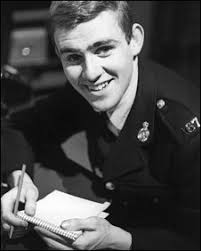
A sleek red American convertible car, A Plymouth Satellite, was imported from the U.S. specially for the occasion, and prior to the Prince’s arrival I had to drive it to every location on his itinerary to make sure there would be no problem with its size. The only areas of concern were a few of the narrow alleys in St. George’s, where the speed limit still happened to be just 15 miles per hour.
I drove down to St. George’s by myself early one morning just after dawn and on reaching The Causeway I had an irresistible urge to see how fast the car would travel. After rounding Stonecrusher Corner at about 50 miles an hour I hit the gas pedal and zipped along Kindley Field Road reaching a speed of just over 165 kmh which I later checked and realized was over 100 miles per hour. There was not a vehicle in sight. I had no problem with those narrow lanes which I took very slowly!
When Prince Charles arrived at the airport I was there to pick him up with H.E. Lord Martonmere sitting in the rear seat alongside the Prince, who was wearing a suit, and Inspector Les Waddell riding in the front, no doubt armed to the teeth! I was wearing full ceremonial uniform with white uniform dress jacket, white gloves and police cap.
We headed for City Hall in Hamilton accompanied by a motor cycle escort headed by Inspector Harold Moniz, and I was instructed to maintain a speed of at least 30 miles an hour and keep up with the motor cycles at all costs. As we passed Francis Patton School on North Shore Road the whole school was outside and the children were waving flags and were so excited, but they hardly saw a thing because we whizzed by so fast. At that point Prince Charles leaned forward and quietly remarked that if we passed any other schools we should slow down for the children to have a better view.
All was well until we approached Saltus Cavendish primary school on Middle Road in Devonshire, next to Watlington Road where all the children were assembled around the school entrance. I slowed down as per the Royal instructions but Harold Moniz was furious! He dropped back almost parallel with the car and signaled me to speed up immediately.

We arrived safely at City Hall where the grounds were packed to capacity, and as soon as the Prince and H.E. left the car Harold came storming over and accosted me about disobeying his orders. I politely explained my dilemma; do I follow the instructions of my senior officer, or the commands of His Royal Highness, the Prince of Wales? All was forgiven!
I had a most enjoyable five days driving the Prince around the Island, and at the end of his visit I was called in to see him at which time he thanked me for my services and presented me with a signed photo of himself. It was much appreciated.
Just one postscript to the Royal visit. Marian at that time was working for a lawyer, David Brewster at Appleby, Spurling and Kempe's law firm, and David’s son was one of the young boys at Cavendish School. David told Marian that after the Prince passed them, the children all trooped back into school and had to write a story about seeing the Prince. Without exception every single boy described the handsome young Prince - wearing his smart white uniform and cap!
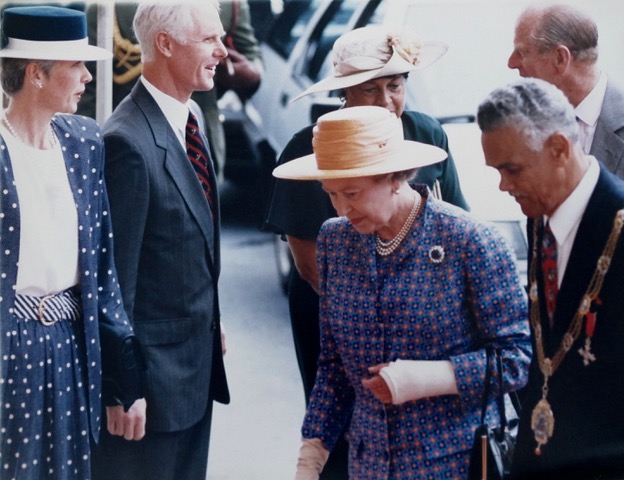
Many years later Marian and I were privileged to stand on the front steps of City Hall, in my capacity as Secretary to the Corporation of Hamilton, together with the Mayor of Hamilton, The Rt. Wor. Cecil Dismont and his wife, to greet Her Royal Highness Queen Elizabeth and her husband HRH Prince Phillip on their official visit to Bermuda in 1994
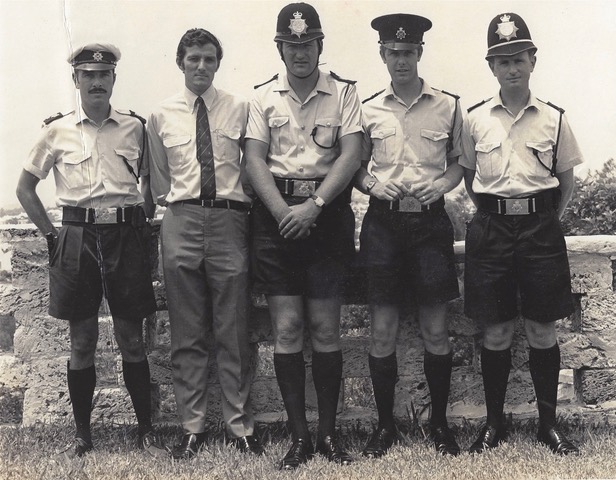 Sergeants promotions - 1971
Sergeants promotions - 1971The Island was rocked on 10th March 1973 when Governor Sir Richard Sharples and his ADC Captain Hugh Sayers were shot and killed in the grounds of Government House, which greatly heightened tensions in Bermuda. Not long after the assassination I was involved in a nasty incident when two men, who later turned out to be linked to the murders and robberies that followed the assassination, came into Davidson’s enquiring about purchasing something, and for no reason they started shouting and threatening me. I felt helpless to do anything about it as a civilian which made me realize that I needed to return to the Police Force. It was then I decided to apply to re-join the Police.
“Gruff” Hammond, as Head of CID, was most put out, and sure enough, I was accepted back in the Force and duly assigned to the one department I wasn't keen on, returning to work at Central CID in June 1973. It turned out to be a great move because I thoroughly enjoyed the next couple of years as a detective.
I was put in charge of the investigation and reported back to “Chief” Donald who was OIC Central CID. The case involved a bunch of characters straight out of a TV drama including an eastern European artist, an American entrepreneur from Brooklyn who turned out to be the investor and nightclub owner, a Bermudian businessman, and two lawyers from Grey’s Inn Law Firm – Charles Vaucrossan and Dennis Chandler.
The evidence gathered pointed in the direction of the two lawyers being directly involved in illegal activity and this resulted in me obtaining a search warrant for Grey’s Inn from the Senior Magistrate, James Rufus Astwood, who read it carefully and commented that this would really “put the cat amongst the pigeons!” Unbeknown to me on the day we decided to execute the search warrant, Charles Vaucrossan, who was then Chairman of the UBP, was opening the annual UBP conference at the Southampton Princess Hotel. Nevertheless, I arrived at Grey’s Inn with warrant in hand and entered the premises where I was confronted by lawyer, Walter Robinson, who was a partner in the firm.
Mr. Robinson decided that bluster was the order of the day and he stood directly in front of me informing me that lawyers were “privileged” and I had no right to be on the property. After diplomatically advising him that I had a legal warrant I intended to execute, he remained confrontational until advised that if he continued to obstruct me he would be arrested for obstruction of a police officer carrying out his lawful duty.
He finally moved out of the way and then asked me to wait for a few minutes while he made a telephone call. Within minutes a whole gaggle of lawyers appeared from nowhere soon after I told Mr. Robinson that I had every intention of executing the search warrant despite him vehemently objecting that any lawyer/client correspondence was protected by lawyer/client privilege. I guess that depends on just who is committing the crime!
After trying in vain to persuade me not to execute the search warrant, the lawyers all trooped off to Supreme Court to complain to the Chief Justice who apparently told them that he could not interfere with a criminal investigation, then off they headed to Magistrate’s Court to speak with the Senior Magistrate who gave them short shrift! The Wor. James Rufus Astwood went on to become the Chief Justice and also President of the Court of Appeal. He was a giant in the legal community.
On their return to Grey's Inn I was told the search could only be in connection with the matter of the Zodiac Palace, but in any event, I was able to seize two almost identical minute books, one containing false minutes claiming that Mr Hilgrove Gordon was the owner of Zodiak Palace, and another clearly indicating that the true owner and investor was a certain Mr. Chin from Brooklyn who I subsequently interviewed at his place of business in Brooklyn. I was assisted in this investigation by Mr. Tony Bigwood from the Accountant General’s office and he did a superb job in sifting through all the files connected with the case.
The evidence collected was incontrovertible and after loads of negotiations between lawyers and the AG’s Chambers all the principal parties plead guilty to slightly reduced offences resulting in heavy fines and disbarment from practicing law for Charles Vaucrossan, and Dennis Chandler who I understand was on the verge of obtaining Bermuda status when the case concluded which resulted in him having to leave the Island forthwith. One point I should mention about Charles Vaucrossan, who was disbarred for 2 years to the best of my recollection, is that when I interviewed him he was totally frank and honest about the case and made a full confession.
I spent just over two years in CID as a D.C. and looking back now I realize it was a very special time. During those two years I dealt with several unforgettable cases including a tragic murder in which a man poured inflammable liquid over his wife and set her on fire while she was sitting on a settee in their living room on Angle Street with their young baby daughter in the room. She had discovered that her husband had been having an affair with another women after she was diagnosed by her doctor with an STD. The victim was admitted to King Edward Hospital with horrendous burns, and several days later she was flown to a special burns unit at a hospital in Baltimore, where she died in agony.
D.C. Merv Willey and myself flew to Baltimore to continue the investigation, Merv to take photos and seize forensic evidence, and me to interview hospital staff and nurses regarding whatever the poor victim might have told them about how she came by her injuries. At that time Baltimore was classed as the murder capital of the U.S. and we were assigned to a Baltimore detective who assisted us during our time there. While doing so he also had to deal with 3 murders over the same weekend. That was more murders than we would ever have had in a year here in Bermuda!
The end result of our investigation was that the husband was convicted of manslaughter.
“CD” had explained the highly sensitive and confidential nature of the investigation, and that only three people in Bermuda knew about it - himself, myself, and D/Supt Frank Hammond, head of CID.
I had no idea how John Ferguson, a Canadian, could have heard about the matter so I went over to his house and casually asked him what he knew about an investigation into some senior Canadian official. He had no hesitation telling me the source of his information. He had attended a social function at Government House and was told by none other than Mr. L.M. “Nobby” Clark – our Commissioner of Police. What a relief!
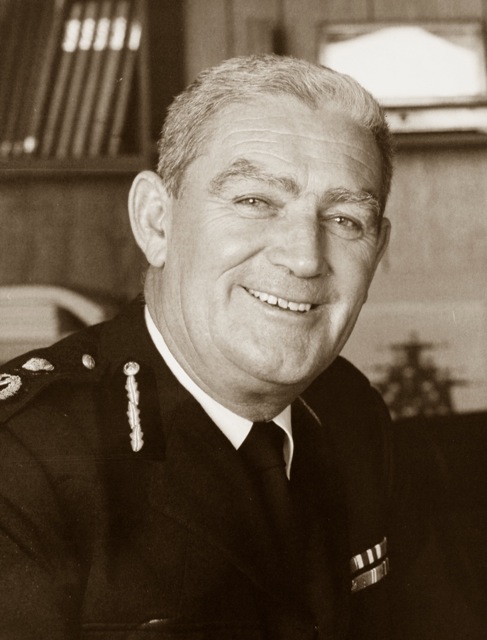 Commissioner of Police L.M. "Nobby" Clark
Commissioner of Police L.M. "Nobby" Clark
I duly spoke with “CD” and must confess to being delighted to let him know I’d obtained a frank 'confession' from John Ferguson that his informant was “Nobby”! NFPA
I spent 2 ½ years in Central CID and for much of that time I was investigating white collar crime in the days before we had a Fraud Squad.
I returned home 2 months before our first baby was due and was promoted again to Sergeant on 1st October, just 3 weeks before our daughter Joanna was born.
“B” Watch was the most dynamic Watch I ever served on. I just had to make one change. This was still a time when many policemen were still heavy smokers, even in patrol cars, and I would get car sick if accompanied by a heavy smoker. I introduced a new rule - no smoking in the Sergeant’s car.
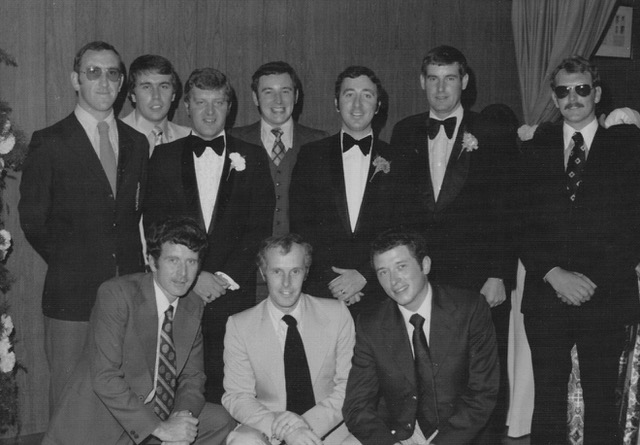
There was great camaraderie on “B” Watch which at various times included Barry Higham, Charlie Mooney, Ray Bell, Roger Brydon, John Baxter, Bruce Bingley, Davie “Pointed Stick” O’Meara, Dennis Gordon, Archie Husbands, Tony Laughton, Bob McDonagh, Andy Hall, the partnership of Roger Beschizza and Lyndon Lewis, along with George Rush whose razor sharp wit kept us all on our toes or on tenterhooks. I used to keep a tally of all tickets issued and know for a fact that our Watch exceeded all the other Watches then in Traffic, although to be fair, Beschizza and Lewis seemed to be of the belief that if a motor vehicle moved it should receive a ticket!
Charlie Mooney later wrote about “B” Watch, “There was no finer group of men within the Bermuda Police Force in the 1970s. They all worked very hard together but they also played very hard together when not working and this included their families.”
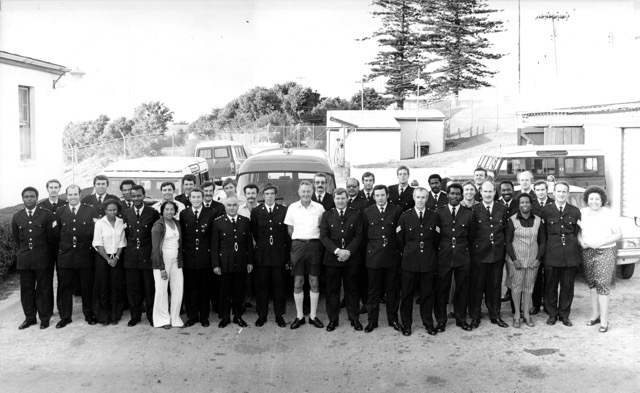 Operations Traffic Division - November 1978.
Operations Traffic Division - November 1978.Back Row (l-R)Anthony Taylor, Roger Brydon, Hiram Edwards, John Instone, George Rushe, David O’Meara,
I attended the accident in the Sergeant’s car accompanied by P.C. Archie Husbands and we passed the number onto the radio operator. We were both surprised to learn that the owner was none other than P.C. Bruce Bingley who normally worked on our Watch. I figured that the car must have been stolen and asked the radio operator to call Bruce at home which he did. Minutes later the operator told me he had just spoken to Bruce who was waiting for me at the house where he was staying in Fairylands.
When we arrived at the house the car was in the garage, still hot, and with fresh damage to the front indicating it had been in collision with a motorcycle. There was a light on in the kitchen and we called out to Bruce who we thought would come out to us. As we stood by the open kitchen door I could hear the sound of labored breathing on the floor near the door as though someone had collapsed. I went inside to see what was making the noise, while still calling out for Bruce. The noise turned out to be a large dog on the floor, asleep and snoring, and at that point P.C. John Wright came out to the kitchen apparently having heard us calling out. He was sharing the house with Bruce.
He took us down to Bruce’s bedroom where Bruce was lying on the bed and was obviously extremely drunk. We had a conversation and I decided that there were sufficient grounds to arrest him on suspicion of driving while impaired, dangerous driving and failing to remain at the scene of an accident. P.C. Husbands and I escorted Bruce to our car and took him to Hamilton Police Station where he was processed and remained in custody until the next morning.
Later that day I heard that Bruce and John had alleged that I had forced my way into the house and violently assaulted Bruce in making the arrest. Nothing could be further from the truth, and Archie made a statement fully supporting my version of the events of that night.
Bruce went to court, pleaded not guilty to all the offences, and maintained the assault allegation against me but he was found guilty of all the charges by the Magistrate, was fined and disqualified from driving. He was then discharged from the Force but that was not the end of the matter - far from it.
He appealed his conviction, and remained under suspension until the matter eventually went before Justice Walter Robinson who had recently been appointed to the Supreme Court, with Solicitor General Saul Froomkin representing the Crown. As mentioned earlier I’d had dealings with Walter Robinson while working as a detective in Central CID when executing the search warrant at Grey's Inns Law Firm in connection with the Zodiac Palace investigation.
I tend to think that our confrontation at Grey’s Inn might have played on his mind when Justice Robinson heard the appeal because he severely criticized my conduct and upheld Bruce’s appeal. I was present in the Appeal court when Justice Robinson handed down his judgement, and on the way out of court the Attorney General, Saul Froomkin, came over to me and told me not to be in the least bit worried because the judgement would be appealed to the Court of Appeal and would, without doubt, be thrown out. Saul sounded supremely confident, and sure enough when the Court of Appeal heard the case they listed some 23 errors in law made by Justice Robinson, found Bruce guilty of all charges, and commended me for carrying out my duties in arresting a fellow officer under very difficult circumstances.
I have to say this was a sickening case from start to finish. Bruce was a valued member of our Watch and I had never had a problem with him. I was aware that following the case in Magistrate's Court there was a great deal of resentment by some of the watch members, and their wives, against me for having arrested him, and the fact that both Bruce and John had accused me of assaulting Bruce was believed by some. Sadly, some of their wives would have nothing to do with Marian even though we had all been good friends and often socialized together prior to the case. Whatever they might have thought, this was a blatant case of drunk driving and hit and run, the evidence showed beyond doubt that Bruce had been drinking for most of the day prior to the accident, and should never have been allowed to drive his car that night. If anyone was to blame for the events of that night it was his fellow drinking buddies.
There are two postscripts to the Bingley case. About two years later I attended an incident on Happy Valley Road where a young lady had made a minor complaint, and when I told her my name she started to apologize profusely to me and explained that she had been at the house in Fairylands with John Wright on the night of the arrest of Bruce Bingley, and later in the morning she had overheard John and Bruce concocting a story that I had assaulted Bruce in an effort to get him off the charges. She had remembered my name and told me she had had it on her conscience ever since that night. By this time Bruce had long left the Island as had John Wright.
Ironically, in March 2015 the Mirror newspaper in the UK reported that a man named John Wright was convicted with another man of being involved in a “Mammoth drug smuggling operation in Britain" in which they were caught by undercover police smuggling 30 tonnes of cannabis which was said to be the largest drug conspiracy to be prosecuted in the U.K. The photo clearly showed that it was the same John Wright who worked as a policeman here. He was sentenced to a long term of imprisonment.
CLICK HERE for the article about John Wright's drug conspiracy conviction.
The Tall Ships came to Bermuda in June prior to sailing to New York, and they looked spectacular in Hamilton and St. George’s. Our police photographer, Paul Farrell, took a series of splendid photographs as they were setting sail to New York, including two ships involved in a collision. We took advantage of the opportunity to see the Tall Ships here first, then we flew up to New York with our 10 month old daughter Joanna at the invitation of our wonderful lifelong American friends, Tom and Monica Coyle, and witnessed the Tall Ships parading up the Hudson River. Tom and Monica were regular visitors to Bermuda having first arrived here during college weeks, and they became an integral part of our family as our children grew up.
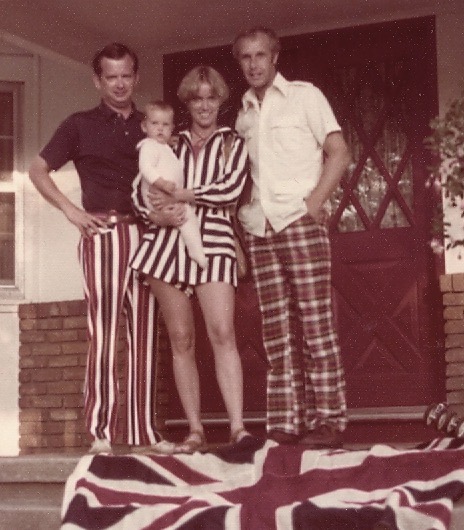
We produced a series of history boards covering such topics as the history of the Traffic Department, some of which are still in existence and hanging in police offices, although some were sadly lost. I recall meeting two former police officers who both made an indelible impression. One was former Detective Vernon Jackson who I would describe as a true gentleman who had served in the Police from 1933 -1947 and was a highly intelligent man who was ahead of his time, or rather ahead of the time before men of colour were promoted through the ranks. I got to know Vernon quite well after the exhibition and I’m positive that if all things had been equal when he served in the Police Force he would have risen to the top ranks.
The other was George Smith who served from 1924 – 1950 and had risen to the rank of Superintendent. George was from the UK and I believe he had family in Bermuda when I met him in 1979. He was a delightful character and he described how, as a young detective in the early 1930’s he worked at Central CID at the time when Charles Edward “D.O.” Simons was in charge of CID. This was another example of a man of colour not being able to rise through the ranks. Charles Simons had been appointed as the first detective in Bermuda in 1919 and for quite a few years was Bermuda’s only detective, investigating all serious crimes. George gave “D.O.” the highest praise and described how he held the position of “Detective Officer” in charge of CID until he retired in 1935.

The Police Exhibition was an outstanding success and really helped to stimulate interest in the history of the Police Force, uncovering much information that had been either lost or forgotten.
I recall a tricky incident when it was decided to include a police motor cycle at the exhibition but it was impossible to get it upstairs into the main hall so it was hoisted by crane through a side window and made it with hardly an inch to spare. It turned out to be a major hit because all the children who came to the exhibition wanted to sit on it and have their photos taken.
While working in Crime Prevention, John and I had a strong push on the U marking of household items such as VCR recorders which were literally “hot” items during break-ins. We also encouraged the u-marking of motor cycles and any valuable items likely to be stolen, using electric engraving drills or diamond tipped pens which we were able to give away along with U Mark stickers to be displayed outside homes and businesses.
Tragically, John died suddenly in November 1982, and I understand that he was due to get married at the time. He was a great character.
On a hot summer night (no air conditioning) I was lying in bed when I heard the sound of someone opening our fridge door in the kitchen. One or other of our two young children, Joanna and Tommy, would occasionally wake up in the middle of the night and wander into the kitchen then into our bedroom. On this occasion I could hears whispers from the kitchen so figured they must both be up. Seconds later I glanced up and in the dim light I saw the figure of a huge man apparently naked, who had crept into our bedroom and was moving down my Marian’s side of the bed. Without even thinking I found myself standing up on the bed shouting and screaming at the top of my lungs, “Get out of my …….. house” with lots of obscenities thrown in!
The man immediately ran out of our bedroom and headed for the kitchen with me in hot pursuit. I then saw he had an accomplice in the kitchen who opened the outside door, and they both ran out onto our balcony, with one jumping straight over the balcony wall which had about a 15 feet drop into the garden, while the other man ran down the staircase and ran off down Hesitation Lane. I’d recently bought one of those unbreakable police flashlights from New York which I kept on our kitchen counter right next to the door. I grabbed the flashlight and took off after the guy who I could then see had no shirt on but was wearing a pair of dark tight-fitting trousers which gave the impression that he was naked when I first saw him in the bedroom.
I chased him onto Montpelier Road then right on Middle Road heading towards Hamilton. Unfortunately, by this time reality set in for me. I had nothing on my feet which were getting sore, and even worse, I had nothing on anywhere else – not a stitch! As I was approaching Clifton, the residence of the Chief Justice, a car headlights shone up the hill as it was coming from Hamilton. I wasn’t gaining and decided discretion was the better part of value so I quickly turned left into Clifton driveway.
More humiliation was to come though as I headed back home, and turned into Hesitation Lane. My primordial screams had woken just about everybody on our street and they were all standing outside trying to figure out what happened. One lady later described to the police how she heard someone trying to open one of her windows, then it went quiet until she heard someone screaming, then it went quiet again until she saw a man “all dressed in white” walking along the lane - that was me on the return journey!
Marian had by this time called the Police and officers were quickly on the scene. I figured the first guy who jumped off our balcony had to have injured himself but we couldn’t find him. We did find the other guy’s shirt in our kitchen, and there were teeth marks in a piece of cheese taken out of the fridge.
A few hours later D.C. Carlton Adams, who was on CID night duty and had taken possession of the shirt, visited the emergency department at KEMH where he saw two men fitting the description I’d given and one guy was wearing trousers that exactly matched the shirt left in our kitchen. The other guy was getting treatment for a badly sprained ankle! Needless to say they were both locked up and they turned out to be two Jamaicans who had stowed away on a cargo ship destined for Montreal. The ship had tied up at the cargo dock in Hamilton and they crept ashore thinking they were in Montreal, and were both starving.
They had walked up Lane Hill and tried unsuccessfully to break into several houses until they came to the insecure house of a Crime Prevention Officer! We had one casement window at our house which was only secure when it was closed and locked, and we had forgotten to close it that night so they were able to climb through it.
One of the two men had just been released from prison for armed robbery with violence and the other guy also had a criminal record. They both appeared in court the next day and pleaded guilty to the B and E and were sentenced to something like 6 weeks in prison. I was dreading receiving a phone call from the media because that would have been the ultimate humiliation, but as luck would have it, there was no mention of my name or the fact the complainant was a policeman. What a huge relief!
While in the Crime Prevention Department I attended an Instructional Techniques Course at our Police Training School with Insp Barrie Meade as the Instructor in late 1979. Barrie was a great character and kept us thoroughly entertained through the one-week course during which time we each had to give two talks, using techniques which included demonstrating a task to our fellow students.
For my second talk I decided to give a presentation to “new recruits” on the subject of why young single police officers should use "condoms". My talk had to include the demonstration of a skill, so I handed out wrapped condoms to each student, and demonstrated how to put them on – over my thumb! Everyone in the class was in fits of laughter but when I asked them all to follow suit, I had one student, Mike Jent, who simply wouldn’t do it. He explained that he hated the smell of condoms and couldn’t bear to touch them. With much cajoling and jeers from the rest of the class I think Mike finally managed to carry out the task! And I passed the course with no trouble!
In February 1980, I was sent on a 6 week Crime Prevention Course at the Police Training School at Baswich House in Staffordshire, which happened to be at my old County Police Headquarters. It was also within 20 miles of my home town in Biddulph so I was able to spend some time with my parents and family on weekends.
This was the second time I had taken a trip to my home area at the expense of the Bermuda Police, although both were tinged with deep sadness.
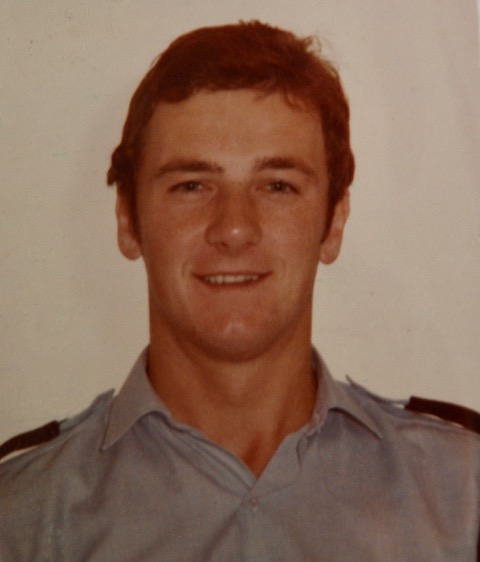 P.C. Damian Willcocks
P.C. Damian Willcocks
Whenever I saw him he was seemingly very happy but sometime towards the end of 1978 he had an apparent mental breakdown and spent some time at St. Brendan’s Hospital. I saw him from time to time while in hospital and he appeared to make a good recovery, but a few weeks later I had a call one evening from Somerset to say Damian was having another breakdown. I drove up to Somerset, picked him up and brought him home to our house in Cavendish Heights. He was obviously deeply disturbed and we had a very difficult night with him walking in and out of bedrooms in a daze, and by early morning I realized he needed to return to the hospital.
It was heartbreaking taking him to St. Brendan’s where he spent a couple more weeks. It was clear he was not going to improve, and after speaking to the psychiatrist and some of his friends, we thought the best course of action was for Damian to go back to his family in Stoke-on-Trent, and I offered to take him home at my own expense.
I have to say that then Supt. Fred "Penny" Bean who was in charge of Admin and Force Welfare strongly supported this course of action and told me the Force would pay for Damian’s repatriation and for my airfare. I escorted Damian back to England and took him home to his mother, impressing on her that Damian urgently need psychiatric treatment. Unfortunately, I got the impression that she thought he would be fine once he was home.
I mention Damian because the first day I arrived at my parent’s home just prior to the Crime Prevention course in February 1980, I happened to pick up the local newspaper, the Evening Sentinel, glanced at the front page, and much to my horror saw a headline about a fatal accident, naming the victim as “Damian Willcocks” who had apparently walked out of a hospital and straight out in front of an articulated lorry.
I got in touch with the local Police and advised them of my knowledge of Damian which was said to have been useful in investigating the circumstances of his death and the inquest that followed. This was a tragedy from start to finish. I believe the inquest concluded that Damian had committed suicide.

Because they were professionally designed we were able to gain corporate sponsorship for not only the stickers but also for a series of colouring books; all credit to the Bank of Butterfield for sponsoring our children's stickers, and Bermuda Fire Marine Insurance Company for sponsoring much of our literature and booklets. We even had a full size Lenny the Longtail costume who made his first appearance in the birdcage along with P.S. Trent Lightbourne in 1980.
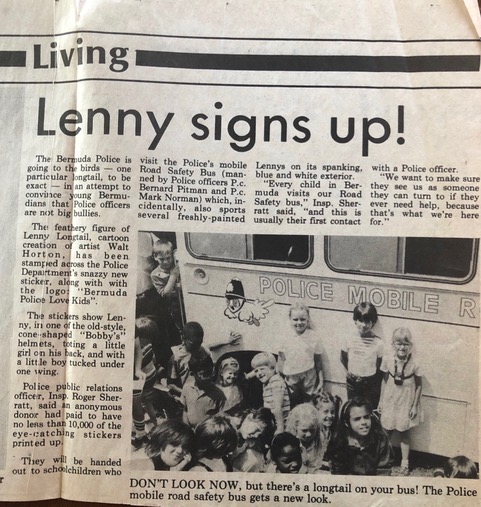

During our time together we introduced several crime prevention initiatives including a Merchants Early Warning System designed to have stores in Hamilton quickly warn other store owners if they were having problems such as persistent shoplifters. We also introduced a Block Security System to make sure there were no weak links in the security of stores in close proximity to each other.
While working with Chris we spent a lot of time and energy promoting the ‘U Marking ‘system. We recommended that persons choose their own unique markings such as their initials and perhaps their date of birth, and then record it with the Police so if we found stolen items with their markings on them we could quickly trace the owners. We even expanded the programme and trained police cadets to make home visits specifically to do free U marking.
Perhaps it’s unique to Bermuda but we seldom had cars and other four-wheeled vehicles stolen, and if they were they would invariably turn up a few days later having been abandoned, It was a different situation with stolen auxiliary cycles and motor cycles. Many were found abandoned a few days later, sometimes with missing parts, but some disappeared although quite a few rusty bikes would be found by Marine Section doing dives in placed like in front of the flagpole on Front Street and off ferry docks around the Island..
That was a time when VCR’s were extremely popular and they, along with televisions, became hot items for theft. CID would often arrest suspects with numerous items in their homes that had almost certainly been stolen, but unless the victims retained model and serial numbers it was next to impossible to prove a case. But the “U marks we used were not very noticeable to the average thief, who would often sell the items on very quickly to someone else. We had quite a few success stories where items were recovered and identified through their U marks, usually household items such as TV’s and VCR’s but it wasn’t so successful with motor bikes because stolen bikes would often be completely re-sprayed and the marks would be hidden.
We also set up and promoted the Neighborhood Watch system, giving talks to groups of neighbors in a particular area, showing them how to use the engraving pens to U mark their property, advising on the best means of securing their homes with door and window locks, and through the use of alarm systems, both local systems, that is, alarms that made a loud noise on the premises, or alarms systems monitored either by the Police or by private alarm companies who would then call the police as required.
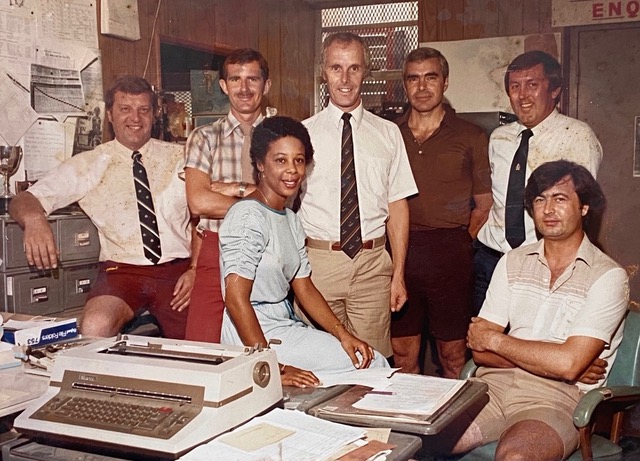 Crime Prevention and CRO Staff in the "tin shack" behind Police HQ
Crime Prevention and CRO Staff in the "tin shack" behind Police HQPrivate alarm companies became so popular and alarm calls to the Police so prolific that we had to set up a system of charging a fee for any system that caused excessive false alarms. P.C. Eddie Davies was brought into the Crime Prevention Department in 1981 as our first Alarms Officer. He helped to design the new policy and ensured that it was adhered to. This was so successful that we were able reduce false alarm calls by over 40% in the first year.
We also obtained several alarm systems that we could install ourselves in order to catch thieves in particular premises. One was a system that would send a signal to Police Operations if a simple switch was activated. I recall an occasion when a Hamilton law firm was regularly having items stolen out of office desks. I installed one of these simple switch alarms in a desk and within days received a call from Operations to say the alarm had just been activated.
I quickly attended the scene and discovered that their cleaner was bringing her teenage son with her to work and he was rifling through desks and stealing anything he thought of value - completely unknown to his mother. He was caught at the scene, and because the theft followed a pattern we asked his mother for permission to search their house for any other stolen items. She felt she had nothing to hide and gave us permission to conduct a search, but on arrival there we were stunned to see dozens of items, including towels and sheets, clearly marked as the property of the Hamilton Princess Hotel. This resulted in the young boy being issued with a caution, but his father was prosecuted for stealing items from his employer – The Hamilton Princess Hotel!
Chris Wilcox was a great partner to work with, very conscientious and always enthusiastic about crime prevention. We wrote articles for the newspaper and often gave talks on radio and interviews on television. I should add that Chris also did a superb job in writing up a comprehensive history of the Bermuda Police which involved much research. If you want to read Chris’s history of the Bermuda Police it is readily available on the official Bermuda Police Service website. CLICK HERE for the Police History site.
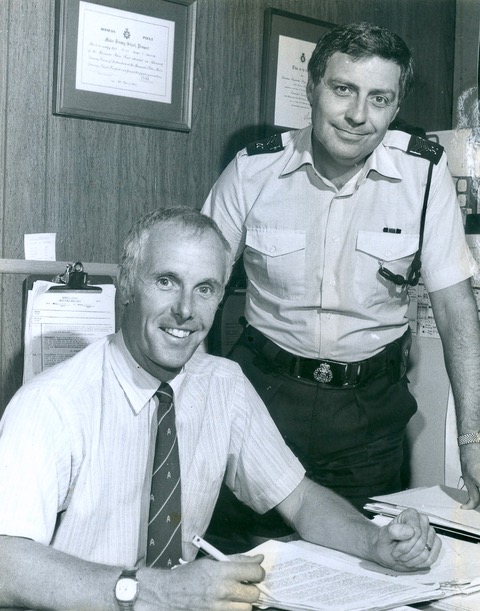
John and I did our level best to keep up with police activity throughout the day by regularly checking all incidents on the new police computer system which was fine for recording incidents but hopeless for typing up reports. For this reason I decided to invest in one of the then new Apple Mac computers for typing. These were very basic by modern standards but invaluable in the 1980’s.
Bearing in mind the advice from John Ferguson I started writing “what if” press releases. This was a case of trying to figure out what we could or would say if the media called us about a particular incident, although our primary aim was to call the media before they called us if possible. This might sound simple but quite frankly, the majority of senior officers would openly say they “hated” the press and didn’t trust them so don’t give them anything. To be fair, I seriously doubt if any senior officers had received proper training in how to deal with the media when they attended senior management courses.
Soon after moving to the Press Liaison Office I received sage advice from Mr. Eric Hopwood who had been the editor of the Bermuda Sun. We met for lunch one day soon after my transfer and I’ll never forget what he said, “Whenever you write a press release you should always write it in language that is easily understood by the average 14 year old.” This might sound condescending but he explained that it’s essential to aim for the widest possible audience and if you use words that are unfamiliar, the reader or listener will quickly lose interest.
At that time he was referring to written press releases because that’s what we usually provided to the media. The alternative was to answer questions from the radio and TV reporters in hope they would quote you directly, but more often than not they seldom got it absolutely right for whatever reason.
One day I had prepared a “what if” press release about an incident the police had dealt with and soon received a call from Chris Lodge at the recently opened Radio and TV station VSB on Reid Street East. I’d followed the advice of Eric Hopwood and written a straightforward release that would hopefully sound like it was “off the cuff”! Chris, whose father had served as an Inspector in the Bermuda Police before my time, seemed to be satisfied with what I said and asked my permission to record what I said on tape and then use it on his newscast. That’s exactly what he then did. From then on it became routine for the radio and TV stations to ask if they could record our answers to questions and use them in the news. Chris told me later that to the best of his knowledge ours was the first recorded news interview and that all the media then started asking permission to record releases not just from the Police but from politicians and other spokespersons.
From our point of view it was ideal because they couldn’t misquote us. Our only problem was if a senior officer didn’t like what we had said we could get a ‘bollocking’ although that seldom happened. Our Commissioner at that time was Fred “Penny” Bean who was quite taciturn, and not a great fan of the media, but he gave us his full support, so much so that John and I became the “official police spokesmen” on most matters.
We were operating it for two or three days and it was a case of trial by fire. We soon ran out of things to say although we tried to have a news updates on the hour and the half hour so we were constantly in touch with Operations to give us any information about road blocks due to fallen trees, downed BELCO power lines, power failures, and damage to buildings or injuries to anyone.
Our biggest problem was silence! This wasn’t a case of slipping home to pick up some tapes (this was well before CD’s) because we were hunkered down at Operations. I have no idea why or how, but we found two tapes – one was rather somber Portuguese music, and the other was Dolly Parton’s greatest hits. I will forever be remembered and mocked by my family for having uttered the immortal words, “And now, one of my own personal favourites, Dolly Parton singing…..” . It just so happens that I really do love Dolly’s music, and Marian and I saw her performing live in Halifax, Nova Scotia a few years ago. She is indeed, one of my personal favorites!
John and I received a lot of positive comments about how reassuring it was to hear our updates on the radio, but a few weeks later we received a parcel from a gentleman from Canada who had been on Island when the hurricane struck. He was a radio DJ and he wrote to commend us for doing a good job on the emergency radio but commented that the music we played had been absolutely lousy so he had produced two fabulous music tapes for us consisting entirely of weather-related music! His selections ranged from, ‘Just blew in from the Windy City’, ‘Raining in my Heart’, ‘Singing in the Rain’, ‘April Showers’, ‘Blowin’ in the Wind’, ‘Crying in the Rain’, ‘Rain, Rain Rain’, ‘Raindrops keep falling on my head’ etc etc. We rocked the next hurricane blackout!
A short time later we had a visit by Her Majesty’s Inspector of Overseas Police Forces, and I heard that the HMI had been discussing with Mr. Bean the need to better coordinate press relations and efforts to improve the relationship between the police and public. I heard that Mr. Bean pulled out my report and told the HMI that we already had a plan!
Soon afterwards we officially became the Police Community-Relations Branch (CMR) and we had responsibility for coordinating Outward Bound, the Road Safety programme and the annual Pedal Cycle Gymkhana. We moved over to the former McBeath Block which was being converted to offices for Murder Squad and CMR. That was the time when I purchased an Apple Mac to prepare press releases and type reports. It was a great improvement from typing everything on electric typewriters!
It was also a time when most of our senior police officers were averse to ever speaking with the press, with several not only being hostile to the press, but would be hostile to John and I when we provided information to the media even though that was an essential part of our work.
Commissioner Fred Bean had taken over as COP in the spring of 1981 and I can say with no fear of contradiction that he always felt very uncomfortable having to deal with the media although it was sometimes essential that he did so. His Deputy while I was in CMR was Clive Donald who was a good friend of mine through our squash playing days, but he too was never comfortable talking to the media.
I had worked with John Instone since our early days walking the beat and living in the barracks at St. George’s, and for as long as I had known him John was a heavy smoker. We had worked in cramped conditions next to the Admin office and life became much more bearable when we moved across to McBeath Block where the small 10’ x 10’ single men’s rooms were converted into spacious offices – a great improvement.
John had joined the Bermuda Police in 1966, and he and I worked in St. George’s together for about a year before both being transferred to Traffic. I got to know him well because we were both members of the Police Drama Group and he was a very fine actor who went on to brilliantly play the role of Hamlet in a BMDS production. While in St. George’s we both lived in the police barracks where John was well known for falling in and out of love with our American tourists. He was always a pleasure to work with especially during our time in the CMR Department.
In 1986 Gary Venning joined us in the Community-Media Relations. In addition to being a very efficient police officer, also happened to be a first class sailor. I mention this because by this time Marian and I had two young children, Joanna being about 11 and Tommy 10. Marian by this time was working in real estate and after making one particular sale she announced that she wanted to buy a sailboat – a 21' O’Day sailboat to be precise – despite the fact that neither of us had any sailing experience. The deed was done and we became the proud owners of Impulse which was moored in Jew’s Bay in Southampton. Gary kindly agreed to teach us how to sail, and off we went on our first voyage into the Great Sound with two children in tow and all very excited.
I then attended the course at Sussex Police Training Centre in Lewes where one of the major topics was the subject of disaster management. We spent a day at Gatwick Airport going through an exercise dealing with an airport disaster. It was while I was on this course that Hurricane Emily "The Bitch who came for Breakfast”, struck Bermuda almost out of nowhere on the morning of 26th September 1987.
I didn’t hear about it until the next day while I was in London when I visited a public toilet (this is not toilet humour!) and happened to see Creighton Green who owned The Camera Shop on Queen Street, who mentioned that Bermuda had been badly hit by a hurricane.
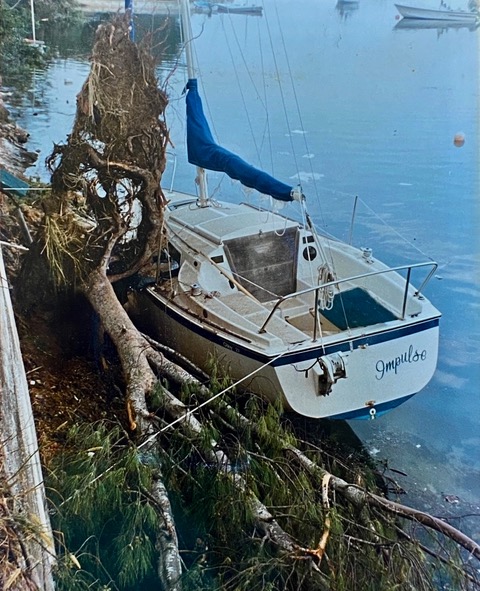
By Monday morning everyone on our course had heard the news and inveigled me to give a talk on how we prepare for hurricanes in Bermuda. They had a good laugh when I described how we filled our bathtubs and every bucket and container with water because we would lose power, possibly for weeks, and fresh water was a necessity.
I returned to Bermuda two weeks later and was stunned to hear that our little Hurricane Emily had apparently crossed the Atlantic Ocean, joined forces with an extreme low off the Bay of Biscay, and slammed into the UK on the night of 15th/16th October with winds recorded as high as 137 mph downing some 17 million trees including six of the majestic oak trees at Sevenoaks which was quickly re-named “One oak” by the media.
A BBC announcer, Michael Fish, famously made the mistake of totally underestimating the storm warning. There were several dozen fatalities including someone in Sussex killed by a fallen tree, and The Great Storm as it was called was said to be the most destructive storm to hit England since 1703. I doubt my fellow classmates were laughing that weekend!
This is not intended as a complaint. It was just a fact of life. With the Police Service led by Commissioner Fred Bean, and Deputy Commissioner Clive Donald, neither of who were at all keen on press conferences or any kind of meetings with the press, our Community-Media Relations branch was kept busy.
We would always be on the lookout for any positive stories about the police such as the time when a police car in Somerset stopped a car for speeding, only to discover that the panicked driver was taking his very pregnant wife, who was about to give birth at any moment, and he was desperately trying to get her to the hospital. The two officers in the patrol car made an instant decision, and decided that rather than transfer the pregnant lady into the police car, they told the driver to follow behind them, put on their blue light and siren, and got them to hospital quickly but without unduly endangering anyone’s life.
All appeared to be well as they sailed away but unbeknown to the organizers the fleet ran into a severe gale on the evening of 3rd June 1984 and one vessel, the Marques was hit by a sudden squall and sank with the tragic loss of 19 of her 28 crew members. According to surviving members of the crew she was hit by rogue wave, turned over and sank within a minute resulting in the tragic loss of 19 lives.
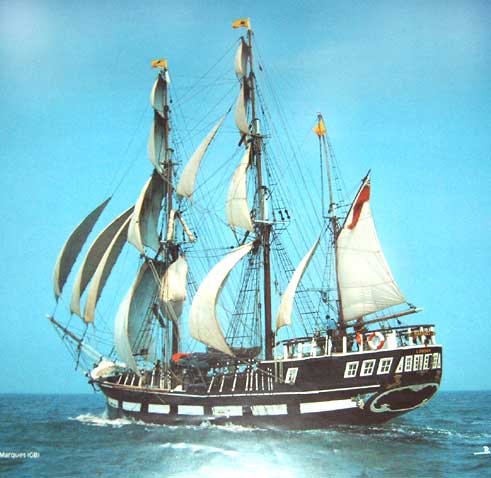 Thee masted brig Marques
Thee masted brig Marques
The Tall Ships Race was organized by members of the UK Sail Training Association who had set up their headquarters in the Hamilton Princess Hotel. Fortunately for Bermuda the organizers were still on Island when news of the disaster came in. News organizations from around the world were inundating the Island with requests for information, and a communications centre was set up headed by Valerie Pethen the Director of Government Information Services. John Instone and myself were seconded to the communications centre to assist Valerie.
We worked around the clock with Valerie and the organizers, trying to piece together exactly what had occurred, what was being done to mount a rescue operation, and coordinate and constantly update responses to questions arising from the tragedy. Calls came in thick and fast from news organisations world wide, and from family members and others. By coincidence, the passports of all the Marques crew had been retained here by the Sail Training organizers (to be flown to Halifax before the arrival there of the tall ships) so we quickly had a list of everyone on board. It took some hours to establish who had been rescued from the life boats by the crews of other tall ships. One body was recovered at the scene, and nine crew members were saved.
John and I worked closely with Valerie and we were kept fully informed of developments by the organizers who did a sterling job, as did Valerie under the most difficult of conditions. Most of the crew members were young people, some of whom were on their first ever sail. By Bermuda standards it was certainly a major disaster, and with the help and cooperation of the Sail Training team I believe the Island handled the tragedy extremely well.
However, he once appeared on VSB alleging that the police, through Special Branch, were monitoring his phone and he had proof in the form of a call he had recorded. Mr. Scott alleged that he had recently been making a long distance call to England when someone came on the phone named Burgess and made mention of being a policeman. He played the recording on television. It was difficult to hear exactly what had been said, but there was no question that the name “police” and “Burgess” (Burgess of course being a fairly common surname in Bermuda) could be heard during the conversation.
John Instone and I heard the news broadcast on VSB but couldn't make out what was being said, so we called Chris Lodge at VSB to ask if we could possibly obtain a copy of the tape played by Mr. Scott. Chris was happy to provide it because we assured him that we would let him know if we could trace where the call came from.
As soon as we heard it John Instone recognized what was being said in a strong southern English accent – John being from Southampton. The words were as clear as day, “Burgess Hill Police Station, P.C. …….. Can I help you.” I’ve forgotten the police officers name but it was easily recognized. It was also clear that the person was answering a call and was an officer at Burgess Hill Police Station, wherever that was. Within minutes we located Burgess Hill Police Station in Sussex, made a call to the Station, and a person answered in almost exactly the same voice, “Burgess Hill Police Station, P.C. ….. Can I help you?”
We explained who we were and why we were calling and he knew the name of the officer on Mr. Scott's tape very well, but he advised us that the officer had been transferred to another police station many months earlier. There was no question that Mr. Scott had mistakenly called a wrong number and finished up accidentally calling Burgess Hill Police Station. Furthermore, although he inferred that his call had been recent, it could not possibly have been because the officer was no longer working there. We provided all of the information to Chris Lodge and invited him to call and check on the information we gave him, which he did. He reported on the result of our investigation on VSB, but sadly I don’t recall Mr. Scott ever offering an apology for his mistake. In fact he stated that he would be reporting the matter to the British Labour Party for them to investigate! That was the last we heard of the matter.
I believe it was very important to always be prepared to respond honestly to potentially negative stories about police. There is nothing worse than a police spokesperson trying to cover up a problem in hopes that it goes away. It NEVER does! But even if the story was about something potentially very negative, it was best to confirm the incident, perhaps explain it from the police point of view, and even more important to say that the matter was under active investigation if that was the case.
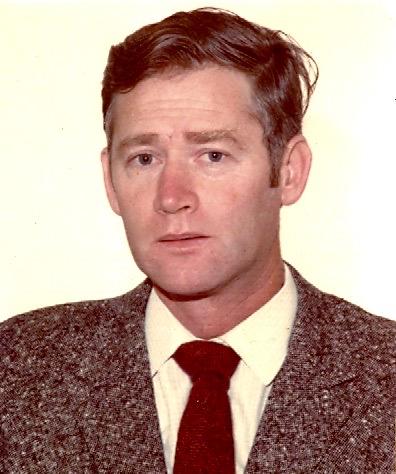 Sgt. Willie Woods
Sgt. Willie Woods The bullet ricocheted around the tiny enclosed room but did no damage except for the fact that Willie was so startled by the blast that he slightly injured his finger or his wrist on the toilet door!
To the best of my recollection, this incident occurred late morning on a Thursday and came to my attention around lunchtime. I immediately wrote a “What if… “ response to any questions we might receive from the press, making it clear that it was an accidental discharge, that the bullet had not caused any injury, and that the matter would be fully investigated.” I must confess to the hope that no-one from the press would call, but that hope was soon dashed.
I received a call from a reporter at the Mid Ocean News about a “shooting” at Government House. I decided to err on the side of caution before releasing any information and promised to call the reporter back again as soon as possible. Time was of the essence for him because the Mid Ocean News was published weekly on Friday mornings, and their deadline for stories was around 4pm Thursday afternoon. There was also an unwritten rule that if the Mid Ocean News printed a story the Royal Gazette would never follow up on it unless it was serious.
I immediately called D.C.O.P. Clive Donald, who was aware of the incident. I explained to him that a reporter was asking about it, and I read out my proposed response. He decided that he would have to consult directly with Commissioner Bean who promptly hit the roof and ordered that under no circumstances should I give the press any information at all as it was none of their business!
I had no option but to call the reporter back and advise him that I was not in a position to comment on the matter. He was an excellent reporter with whom I had a good relationship and he was shocked at this response - with good reason. I had never once during my police career told a reporter “no comment”. He asked if that was the Commissioner’s decision, but I simply reiterated that I could not comment on the matter. This was a classic case of “raising a red rag to a bull!”
The excrement hit the fan! The next morning’s headline in the Mid Ocean News, in huge print, was that there had been a shooting at Government House and the Police refused to comment on it. The Royal Gazette was then all over the case, as were the radio and TV stations. It was now a major story and all of the media were demanding answers.
Just in case anyone is wondering what would have happened if my “What if “ release had been given to the Mid Ocean on Friday afternoon, I firmly believe that there would have been a short article in the Mid Ocean about an accidental discharge of a firearm at Government House. It might even have made the front page of the newspaper but at 4pm on a Friday afternoon it would not have attracted a major change to their headlines, whereas a shooting at Government House with no response whatever from the Police justified the full works.
This was an object lesson in how NOT to deal with the press.
I recall a super-fit marine off a Royal Navy ship being arrested for driving a livery cycle while under the influence and when asked to walk the white line he asked if he had to do it on his feet or his hands! The Sergeant administering the test told him either way, and despite the fact he was clearly under the influence, he promptly did a handstand and walked along the white line and back again without a problem. He was driven back to his ship in a police car! I won’t mention the name of a Sergeant who, when asked by a suspected drunk driver to demonstrate to him how to walk the line, had major trouble showing him how!
Our department was responsible for a PR campaign about the new alco-analyzer (breathalyzer) system which was not exactly popular with the public, to put it mildly! I can still remember the reply from Bermuda’s, first driver to fail the test who, when told he was being charged with impaired driving, replied, “As long as there’s a Goslings I’ll be back”!
Shortly after the legislation was passed a well known carriage (horse and buggy) driver hit the headlines when he was arrested for being impaired while riding his carriage A few days later I had a call from Mr. Peter Woolcock, Bermuda’s internationally acclaimed cartoonist who had a weekly cartoon featured in the Royal Gazette, usually about political issues of the day. Peter had kindly produced a couple of road safety public service ads for our department and he asked if he could visit Hamilton Police Station to have a quick look at the new alco-analyzer machine. I called Hamilton Police Station and spoke with the Station Sergeant, Stanley Hill, who readily agreed to show Peter the machine.
Stanley later told me that he showed Peter into the room where the alco-analyzer was set up, and that Peter spent no more than half a minute in there, but a couple of days later one of Peter’s cartoons was published in the Royal Gazette showing the machine in action, but with a twist! Instead of a person being tested, it was a horse about to blow into the machine, and standing nearby was the Station Sergeant, and there was no doubt about who it was - Sgt Stanley Hill - who was so delighted with his likeness that I believe he bought the original cartoon from Peter which appeared in Royal Gazette on 20 January 1989.
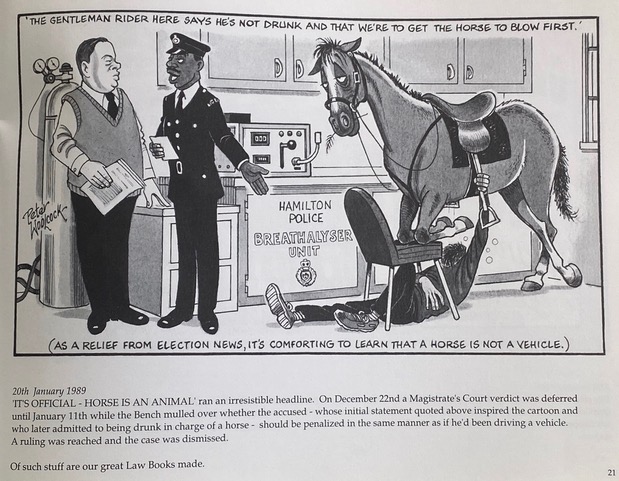
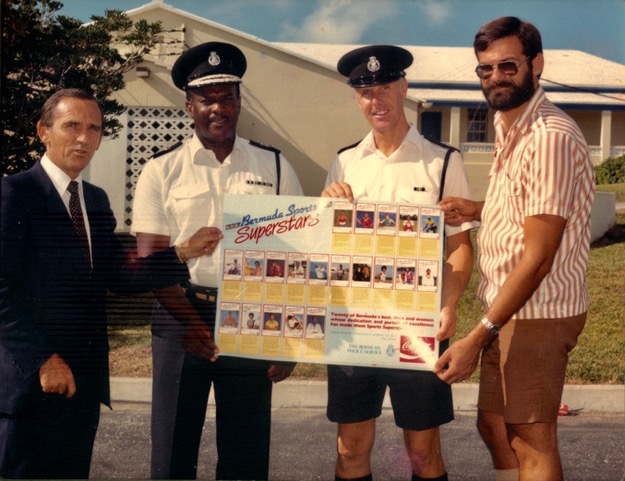
I worked closely with individual sports organizations to select the best athletes who also had to be good role models. The cards were brilliantly designed by Tim Taylor of Aardvark Advertising which was then owned by former policeman Colin “Dusty” Hind. Each athlete chosen had their photos taken in sports kit by Sergeant Ernie McCreight who did a superb job, and every card had a positive comment from each athlete.
The first set of 20 were all of the best of Bermuda’s Superstars, and the second series were all “Juniors Superstars”. The cards were handed out in limited numbers by Parish Constables along with both uniform and CID officers who would hand them out to children and young persons over a period of 6-8 weeks. As soon as children had collected a complete set of cards they were given a large poster with a space for each card. They were extremely popular and were in great demand by children all over the Island.
Of all the athletes selected to be superstars I must mention one in particular and that is young Sean Goater who was then playing football for North Village. Immediately after we launched the Junior Superstar cards, Sean came up to Police Headquarters to thank us personally for selecting him, and when he was later invited to Manchester United for trials he asked me if I happened to have any extra cards for him to take to England. I was able to let him have several dozen cards, and the next time he came home he told me they had been a great success.
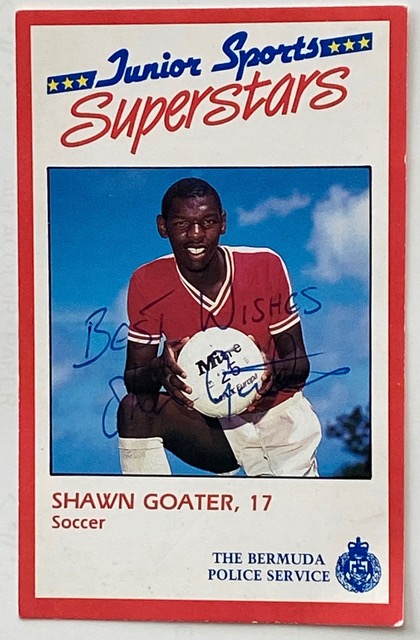
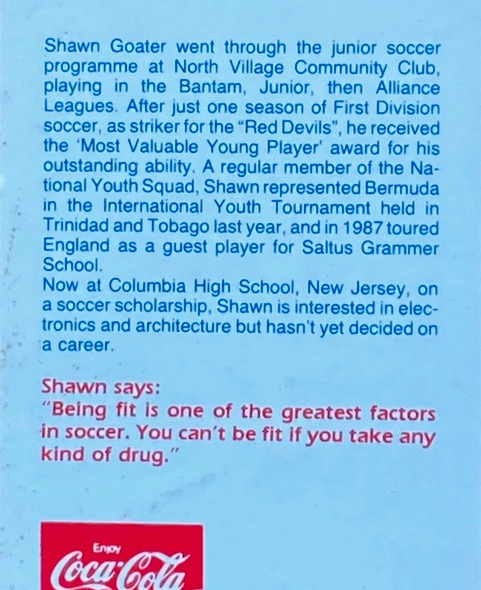
Sean “Feed the Goat” went on to have an absolutely outstanding career as a Premier Division superstar football player who scored over 100 goals playing for Manchester City.
I was very fortunate to work with first class fellow officers in the Community-Media Relations branch. John Instone was always very professional and reliable, as was Gary Venning, and in 1988 when Gary was transferred to the Crime Prevention Department we were joined by Roseanda Jones who I had requested as his replacement.
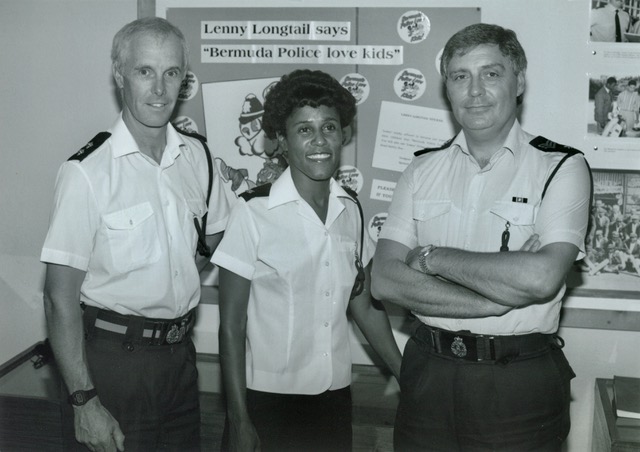 Community-Media Relations Team
Community-Media Relations Team
This was not a job for everyone and it was easy to make mistakes but Roseanda took to it immediately. She quickly gained in confidence and earned an excellent reputation with both newspaper reporters and radio and TV reporters. She was highly self motivated and was always a pleasure to work with. It was no surprise that Roseanda went on to become our first female Deputy Commissioner, and I personally believe she was ideally suited to be Commissioner of Police.
One of our responsibilities in CMR was to look for ways of presenting the Police Service in a positive light, especially to young children in their formative years. As mentioned earlier, our Road Safety programme was organized to visit every primary school where youngsters would go onto the bus to be offered road safety advice. This was an excellent programme then run by Sgt Bernie Pitman and P.C. Mark Norman.
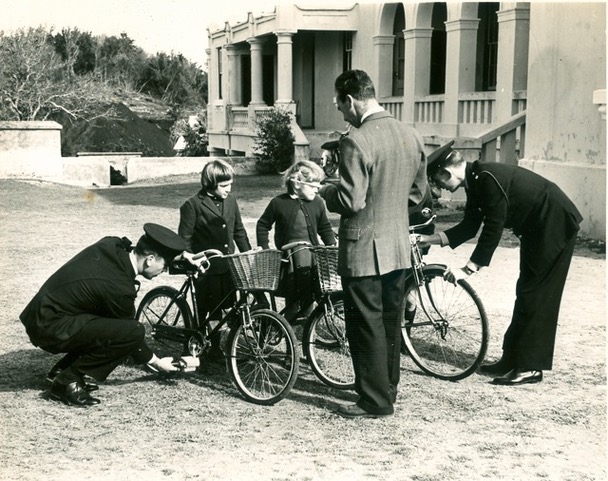 P.C's Peter Stubbs (left) and George Goddard (right) examine
P.C's Peter Stubbs (left) and George Goddard (right) examine CLICK HERE to read more about the History of the Police Motor Cycle Display Team and the first Road Safety Programme in an article about Peter Stubbs on our website in the Hall of Fame column.
I had very little idea of what was involved with the running of OB until I was put in charge of the Community Media Relations Department, and came to appreciate that not only did our coordinators, Bernie and Mark have to completely organize our local courses on Paget Island; they had to select summer instructors from within the ranks of the BPS, and also had to work hard to obtain sponsorship for all the young people who attended our overseas courses held in the UK, arrange booking of flights, transportation to and from the overseas Outward Bound schools, and take care of up to 30 young people.
I was delighted to see that Mark Norman was awarded an MBE in the New Year's Honours List in 2017 for his tremendous contribution to Outward Bound. If ever anyone so richly deserved an MBE it was Mark who devoted most of his career to the Outward Bound programme and in so doing he set a standard that will be all but impossible to match. CLICK HERE for an article we published on our ExPo website in which we reported, "Mark Norman has carried on this tradition in every sense of the word. During his tenure in Outward Bound it has grown in leaps and bounds due to his dedication and hard work - no doubt at the expense of progressing through the ranks in other departments. Mark has positively influenced the lives of many hundreds of young Bermudians to whom he will always be known as 'Mr. Outward Bound' a title he richly deserves to have inherited from the legendary Lynn Hall.
By the time I was in charge of Outward Bound our students were already abseiling down the cliffs at St. David’s Head and having to tackle a new high ropes course which was not for the faint of heart. I made the mistake of visiting the camp several times to check on the activities only to find myself forced against my will to abseil down a cliff face on one occasion, and then clamber up a huge telegraph pole and tackle the high ropes course. Climbing the last few feet to the top of the pole was terrifying, but I managed to complete the crossing - never to try it again!
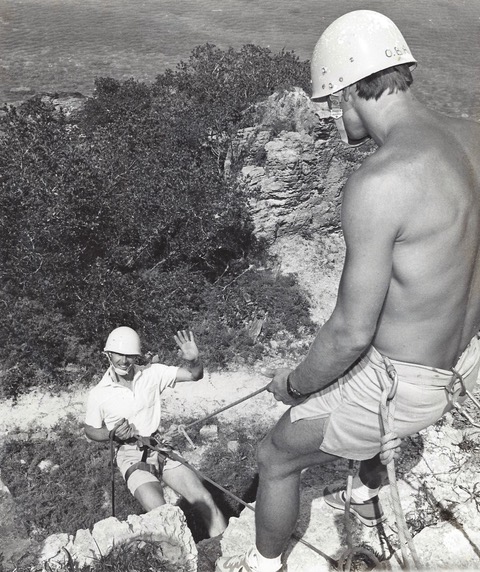 Roger abseils down the cliff at Paget Island
Roger abseils down the cliff at Paget Island
Both of our children completed the local Outward Bound Course long before I was involved with OB, and both said it was one of their greatest experiences, while my wife Marian tested her metal during an abseiling display put on by our Police Outward Bound team at the annual Bermuda Biological Station Open Day when she was persuaded to abseil down the side of the tallest building at the Bio Station. She was determined not to be outdone by the rest of her family!
 Marian finally completes her abseiling conquest!
Marian finally completes her abseiling conquest!
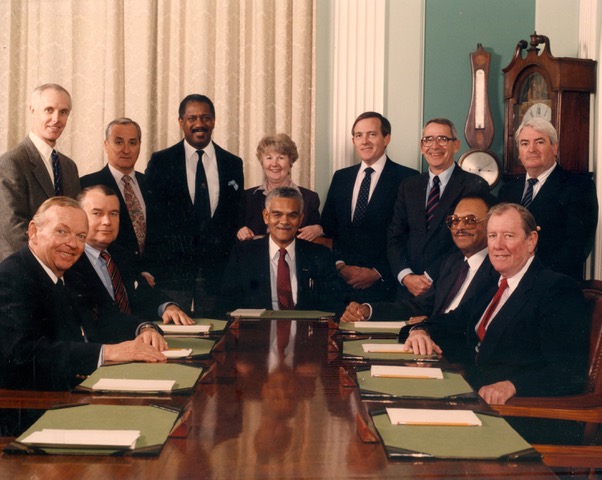
It came at a critical time for me. I had served in the Bermuda Police for almost 29 years, with 3 years prior service in the Staffordshire Police in the U.K. so it came down to deciding whether to remain in the BPS until retirement at 55, or to set off on a new career at the age of 49. I chose the latter, and although I had severe misgivings prior to making the move, I never regretted it for one moment. I had my last working day as a police officer on 31st December 1991 and started my new career the next morning at 9am just 16 hours after retiring from the Police Service. I had 12 years as Secretary to the Corporation and served under 4 mayors before deciding to retire again and move to Canada for a new adventure.
After putting our two children through school and university, Marian decided to pursue further education herself, and after graduating from the Bermuda College with an Associate Degree she was accepted at Dalhousie University in Halifax, Nova Scotia, studying Social Anthropology, while I was still at the Corporation. We got together during college breaks and I would either travel up to Halifax every few weeks or Marian would come home. She graduated with Honours in two years and was then offered a prestigious scholarship to do her Masters. We discussed it at length and the decision was made that I retire from the Corporation and join Marian in Halifax for two years while she completed her Masters, and those were two of the best years of our lives.
On our return I worked for a short while at the Aquarium and then as Acting Director of the Human Rights Commission.
I’m now fully retired and keep busy with family – both of our children, Joanna and Tommy are married and have settled here on Island with their children. Joanna and her husband Martin Wyer (one of the top football referees on Island) have two children, Elizabeth and Eddie, and our son and his wife Sarah have three children, Olivia, Isla and Ben. They all live within a 5 minute drive of our home in Flatts Village.
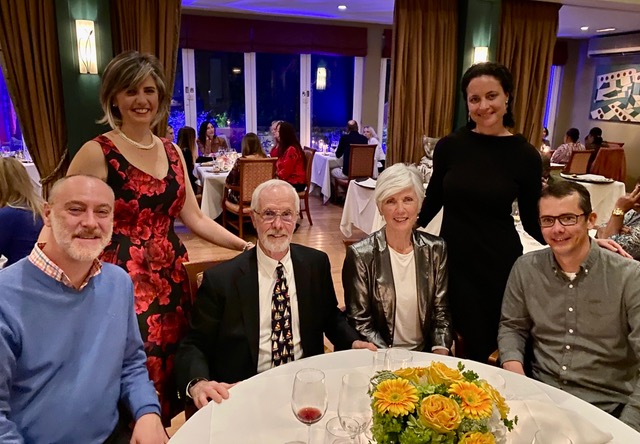 Roger and Marian celebrate their 50th Wedding Anniversary
Roger and Marian celebrate their 50th Wedding Anniversary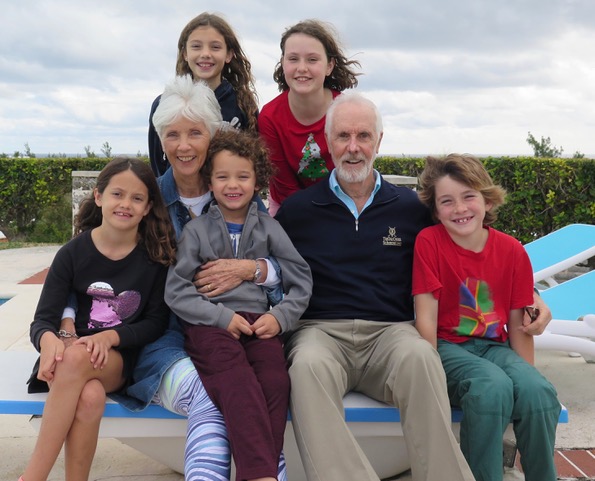 Hands full with our five grandchildren
Hands full with our five grandchildrenI stay in close touch with my siblings who are spread around the world, and my mother until she passed away at the ripe of age of 102. My brother Bruce is an artist who has travelled the world but has settled in Bali where he has his own studio and teaches art at the Bali Center for Artistic Creativity. His specialty is teaching people who say that havn't got an artistic bone in their body! CLICK HERE to view his website. My brother Spencer has his own Pump Engineering company and lives with my mum in the family home, and I also have a much younger sister, Josephine, who was born after I first joined the Police Force in England, who owns her own company, Country Kids, and lives in New York State. So, the three boys from Biddulph are now scattered around the globe in Biddulph, Bali and Bermuda, and our sister spends time in the “Big Apple”!
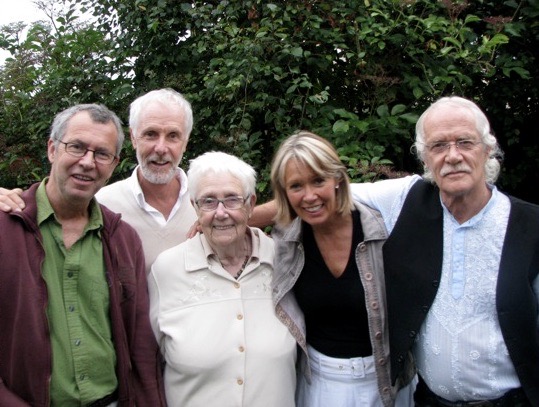 Sherratt siblings at rare gathering with mum who is now 102 years old
Sherratt siblings at rare gathering with mum who is now 102 years old
I served for a year as Vice President and then took over as President, a position I’ve held for 8 years with the help and support of two members in particular, Reese Bartley and Dave Cook. It has been both a pleasure and a privilege to serve on the ExPo committee and I’d like to think that we helped to promote more social activities for our members including annual summer BBQ’s at the Police Recreation Club, our annual post-New Year reception held in January, and active involvement with the annual Police Memorial Services held to commemorate our past members who are no longer with us. This service is held at the Police Cemetery at Prospect followed by a reception at the Police Club hosted by the Commissioner of Police during the annual Police Week celebrations held during the first week of October.
What has really kept me busy though was the creation of our ExPo website in 2011. I had been thinking about how we might help in maintaining and expanding contact with both our local and overseas members, and had a few ideas about creating a website but with absolutely no knowledge of how it could be done and what might be involved. As luck would have it I happened to bring up the idea at the Officers Mess one evening with Bob McLean, a Canadian computer whiz who was working here on a project updating the BPS computer system. I got into conversation with Bob and he was obviously very familiar with the setting up of websites.
I wrote up some ideas on a notepad about a layout for a website, including a ‘Keeping in Touch’ column in which our members both locally and abroad could write and give us their news as to what they were doing and where they are these days; a ‘Then and Now’ column in which our members could write their own reminiscences about their time in the Bermuda Police including how they came to join the Service, where and when they served, write about their personal experiences, their activities, both socially and workwise, what they have done since leaving the Service, and where they are now; a ‘Hall of Fame’ with articles about those of our former colleagues who are no longer with us; an ‘Interesting Articles’ column in which members can write articles about anything from interesting cases they may have dealt with to their hobbies and social activities; a ‘Who, Where and When’ column featuring photos from our Police files and more importantly from any members who submits photos that might be of interest to their former colleagues, and which might test the memories of those of us who are still around. We also have a ‘Latest News’ column and a ‘Press Releases’ column which is intended to keep our members abroad in touch with “what’s happnin’ in Bermuda particularly about the BPS.
It was a most pleaseant surprise and honour to be awarded the Queen's Certificate and Badge of Honour in the New Year's Honours List in January 2017, for support for retired and former police officers through the Ex-Police Officers Association and our ExPo website. CLICK HERE for a report on the Honours List published in the Royal Gazette.
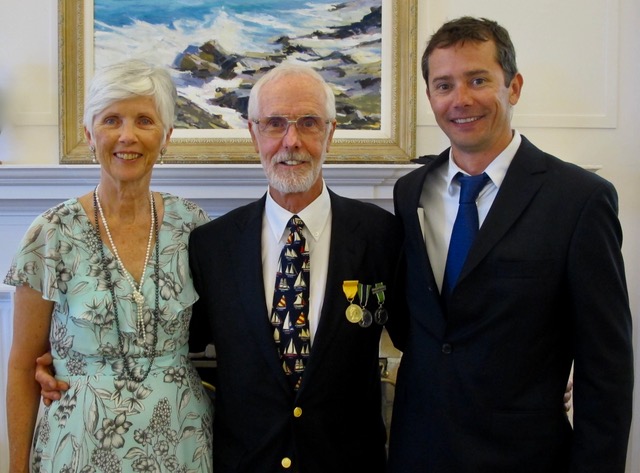 Attending the Honours Award Ceremony at Government House
Attending the Honours Award Ceremony at Government House Although it was a one man band for the first few years, we now have two dedicated members, George Rose and John Skinner who have researched and written a variety of articles many of which are of great historical interest. Examples include George Rose’s expansive article on Edward “Bosun” Swainson (CLICK HERE to view it) who scored the first century in Cup Match and was the first man of colour to be promoted to the rank of Inspector in 1959, and Arthur Childs who was an outstanding boxer in the 1930’s and an exceptional character (CLICK HERE to view it).
One truly remarkable result of George’s research was that he was able to trace Arthur’s wife, Winnie, for her recollections of her husband and his career. I say remarkable because we had no expectation about finding anyone who would have known Arthur way back in the 1930’s when he was drawing large crowds to see him boxing against international fighters. George tracked down Winnie a few years ago when she was over 100 years old, and she is still around and active at the age of 107.
John Skinner has recently written a fascinating article about one of our very first police officers, Thomas James Powell who joined the Police in 1895 after having fought in the Crimean War and was present at the Charge of the Light Brigade at Sebastapol (CLICK HERE to view it). John also recently completed a comprehensive list of names of our Police Officers who served in the Bermuda Police at any time during the hundred years between 1879 when the Force was officially incorporated and 1979 – a herculean task that took him over 12 months to complete. CLICK HERE for John's remarkable 100 year list.
At our annual Ex-Po Reception held in January 2020, Commissioner Stephen Corbishley took George Rose, John Skinner and myself completely by surprise when he presented all three of us with Commissioner's Commendations for our work on the ExPo website, while John Skinner surprised the Commissioner by presenting him with a hard copy of his extensive List of Police Officers 1879-1979 for the new Police Museum at the Officers Mess which was opened in late 2019. CLICK HERE for more information about the annual Ex-Po Reception and awards.
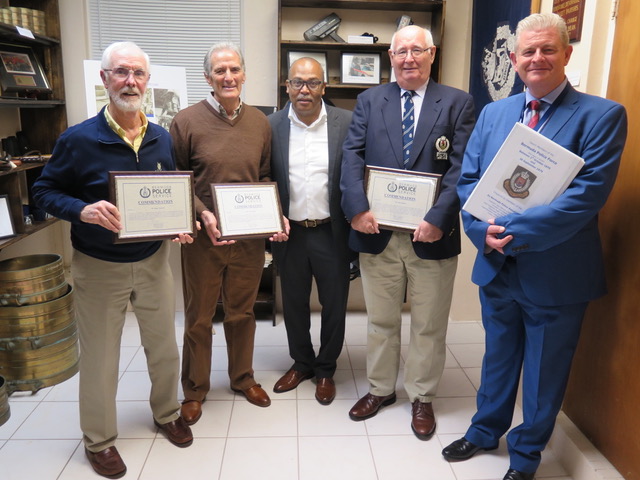
I still edit our ExPo website but 2 years ago the job of President was ably taken over by retired Chief Inspector Calvin “Cal" Smith who is also working as the Commissioner’s Staff Officer. Cal is doing a first-class job as our President, while Gail Correia is doing a great job as our Secretary/Treasurer and keeps us in the modern age running our own ExPo Facebook page. Bermie ExPo is in good hands moving forward.
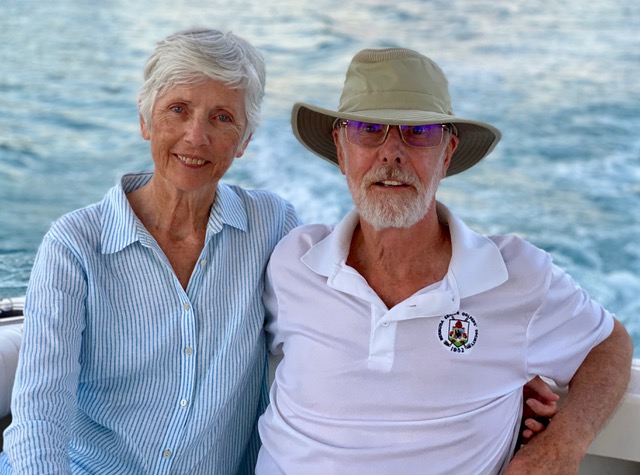 Roger and Marian finding time to relax
Roger and Marian finding time to relax
My wife Marian and I are now fully retired and living in Flatts. We have been avid gardeners since we were first married and still keep our fingers green in our condominium garden, and I also keep active playing golf with the Bermuda Senior Golfers association. We continue to be actively involved in the lives of our five grandchildren, and as of this writing, we're facing the fact that the Covid coronavirus pandemic is a major ongoing concern in Bermuda and worldwide. I sincerely hope that all of our Expo members are staying safe wherever you are.